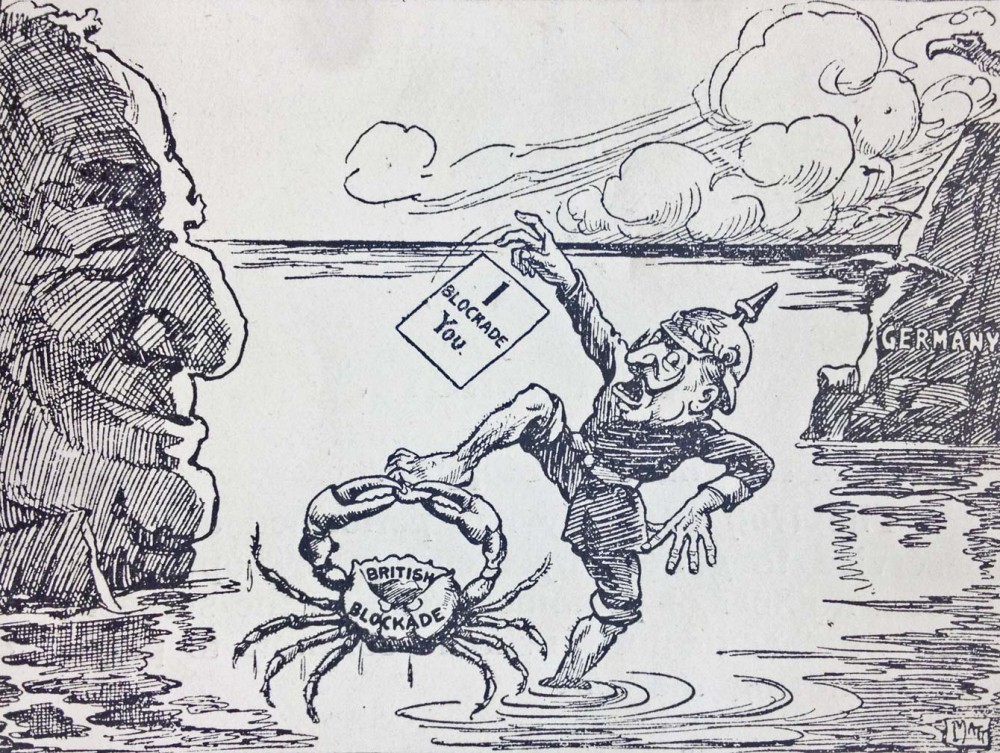 British 1917 Cartoon, ridiculing the German 'submarine blockade' in the aftermath of the Glenart Castle incident"There is little question that
British 1917 Cartoon, ridiculing the German 'submarine blockade' in the aftermath of the Glenart Castle incident"There is little question that Kapitänleutnant
Valentiner broke the rules we set for ourselves here. We cannot prosecute one of our own for what I am sure most of the world would (and already is) label a war crime - the effect on the submariners' morale would be devastating. But he is never to command again; and strict measures are to be taken to prevent such incidents in the future."-Personal memo signed by Admiral von Tirpitz to an undisclosed recipient in the Oberste Merineleitung, declassified in the 1950s
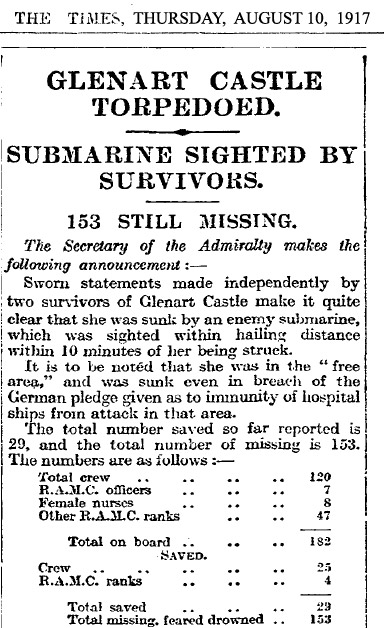
Not the proudest moment for the
Admiralität, not to mention the
U-Boot Command.
Well...
When dealing with such unfortunate events, von Müller and von Lückner decide, the best thing to do is organise another daredevil run. To raise the spirits of the
Matrosen and to perform to the highest standards of seamanship!
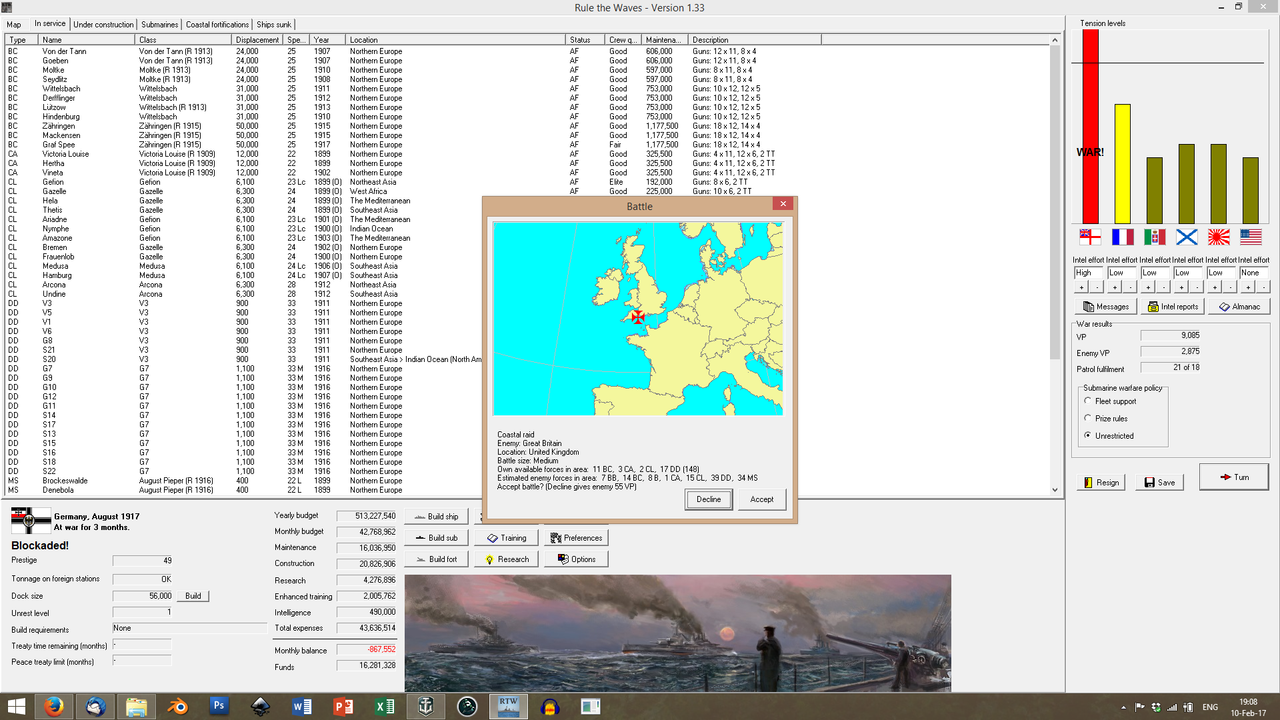
And so, on the foggy, hazy morning of the 18th of August, they take their old, obsolete protected cruisers through the Channel (!), braving minefields, patrols and shore batteries along the way.
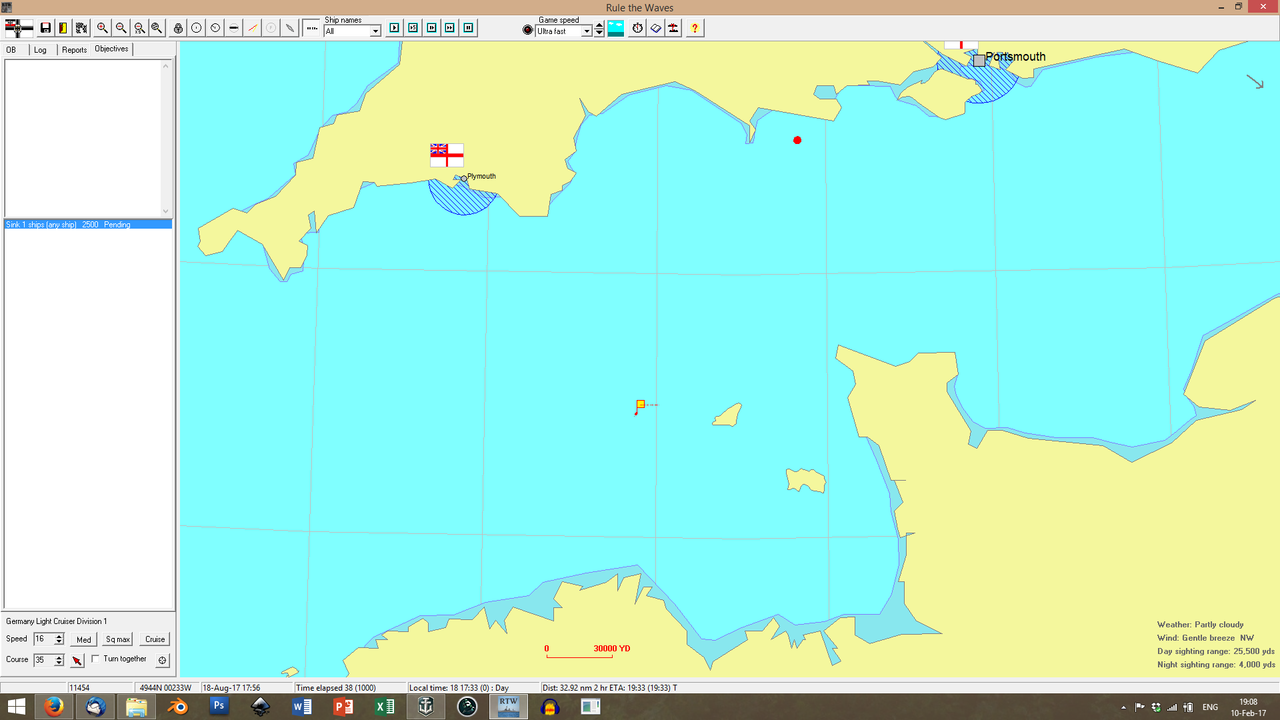
By noon, they have evaded British patrols and reached as far west as Plymouth, passing less than fourty nautical miles away from the British naval base in Portsmouth.
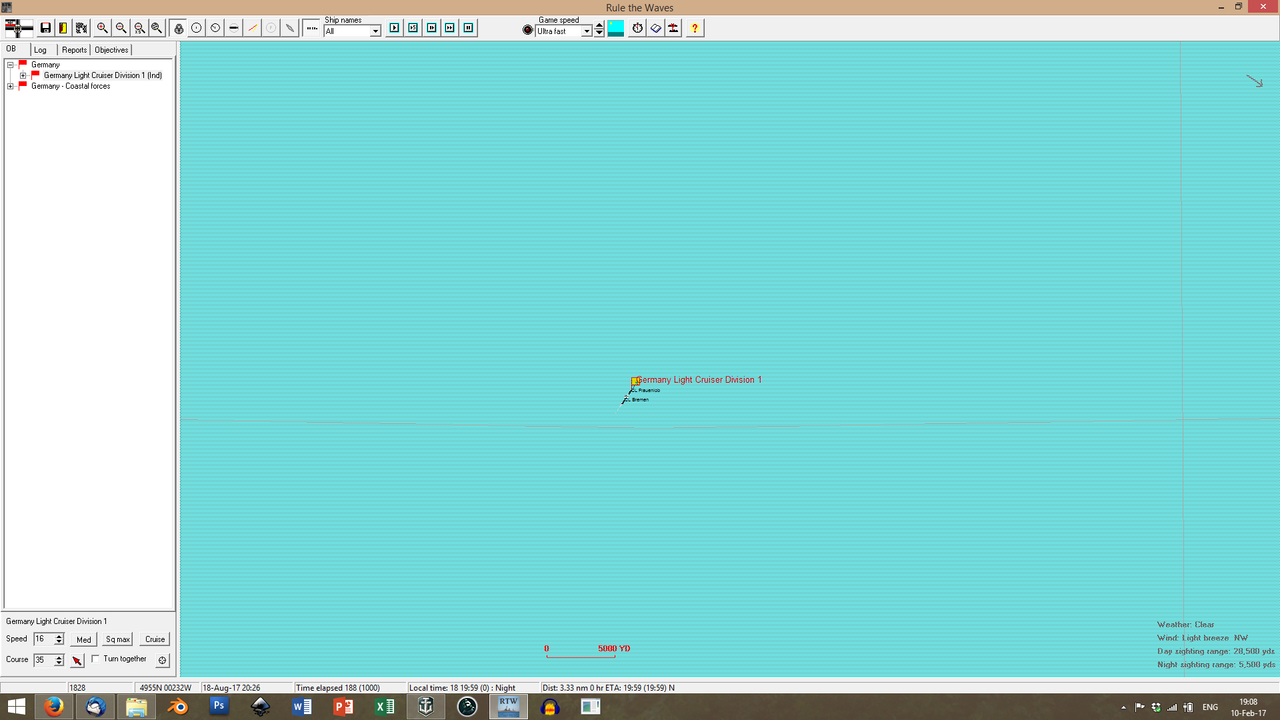
During the afternoon, they retrace their steps, spending the night cruising at low speed near Dieppe.
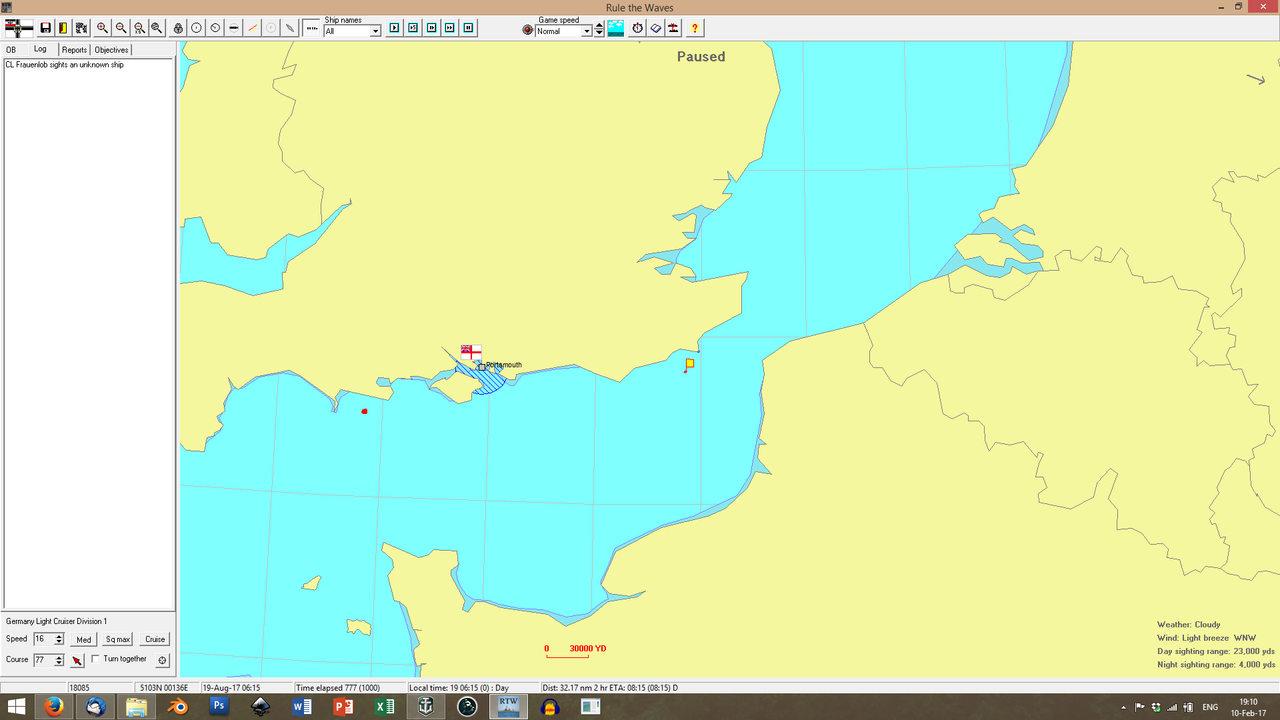
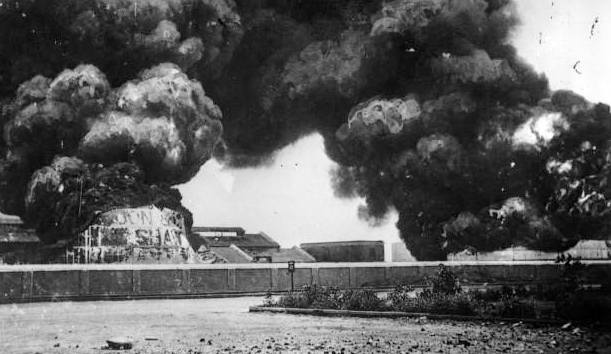
And, shortly after sunrise the next day, they cross the strait at Calais. Von Müller feels cheeky; he takes
Frauenlob near the coastal batteries in Dungeness and opens fire, taking the dozing garrison there by complete surprise. Two eight-inch coastal guns are destroyed and six gunners are wounded in their barracks beds; the German cruisers make good their escape, suffering only minimal damage from sporadic 4-inch return fire.
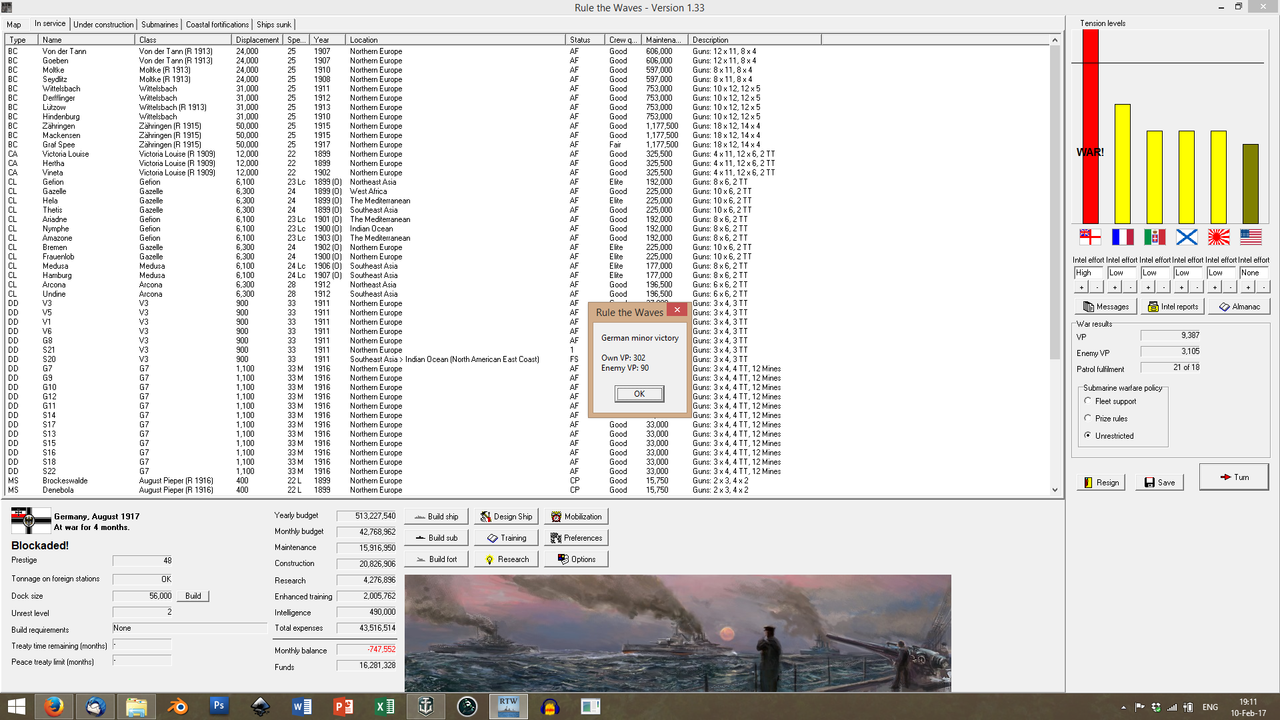
It's no major victory, but it's a glorious display of German seamanship. Von Müller and von Lückner have taken the
Frauenlob and the
Bremen right into the Brits' front yard, essentially unchallenged.
It is interesting to note that the first British reports on the incident mention that a 'German probing raid near Dover was repulsed'; no mention is given to the German cruisers' crossing of the channel. It is only after the war that the German
Admiralität figures out that the Brits
had never realised that the cruisers had ever
passed Dover in the first place.
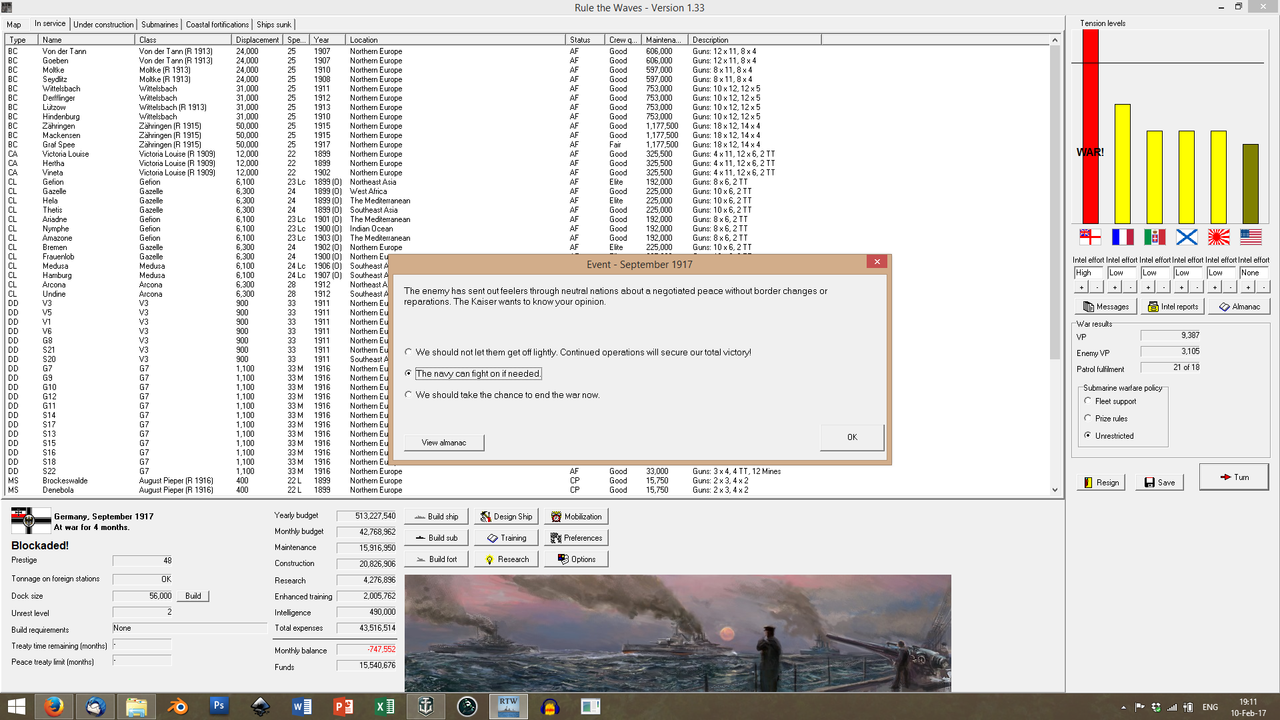
In early September, Britain probes for a white, compromise peace. Von Mecklenburg consults the
Admiralität; Tirpitz and Galster both agree that, even though they have no answer to the British surface blockade (yet), the Navy is willing and able to continue the fight and, perhaps, grant von Mecklenburg a considerably better negotiating position.
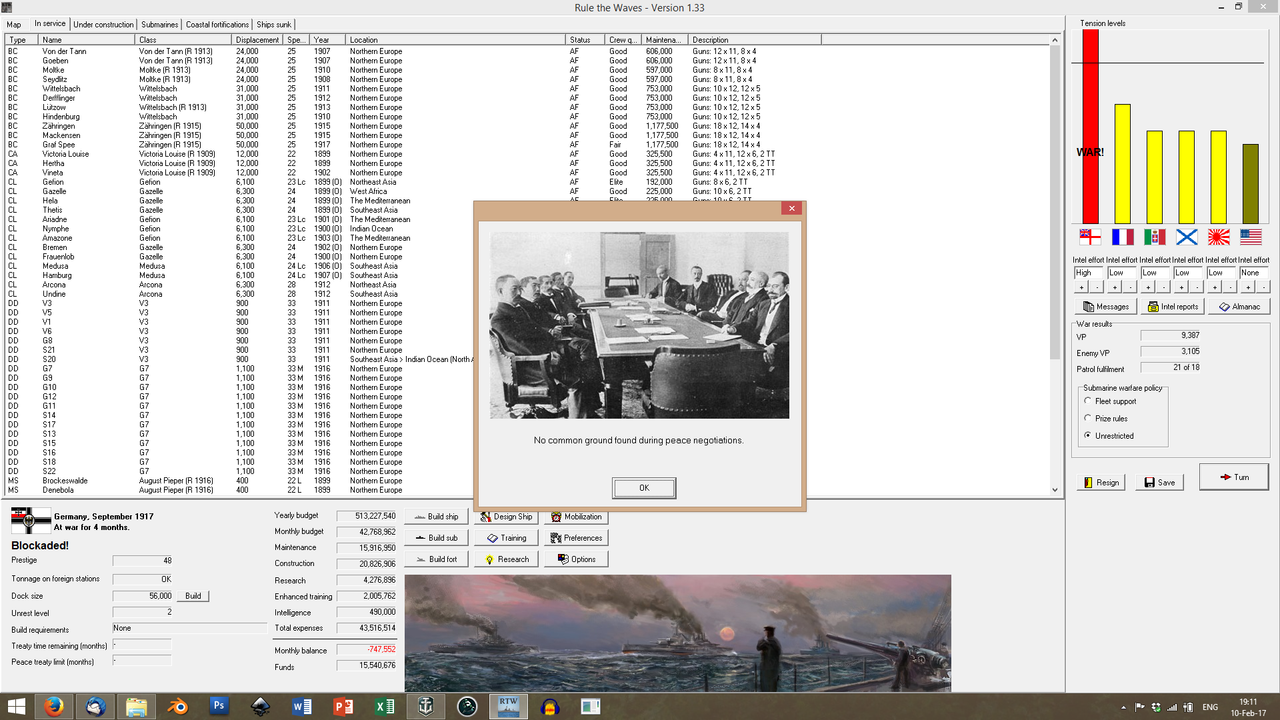
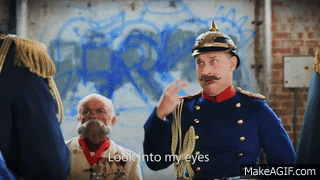
Taking his cue from the submariners, the Kaiser proceeds to absolutely
torpedo the peace negotiations.
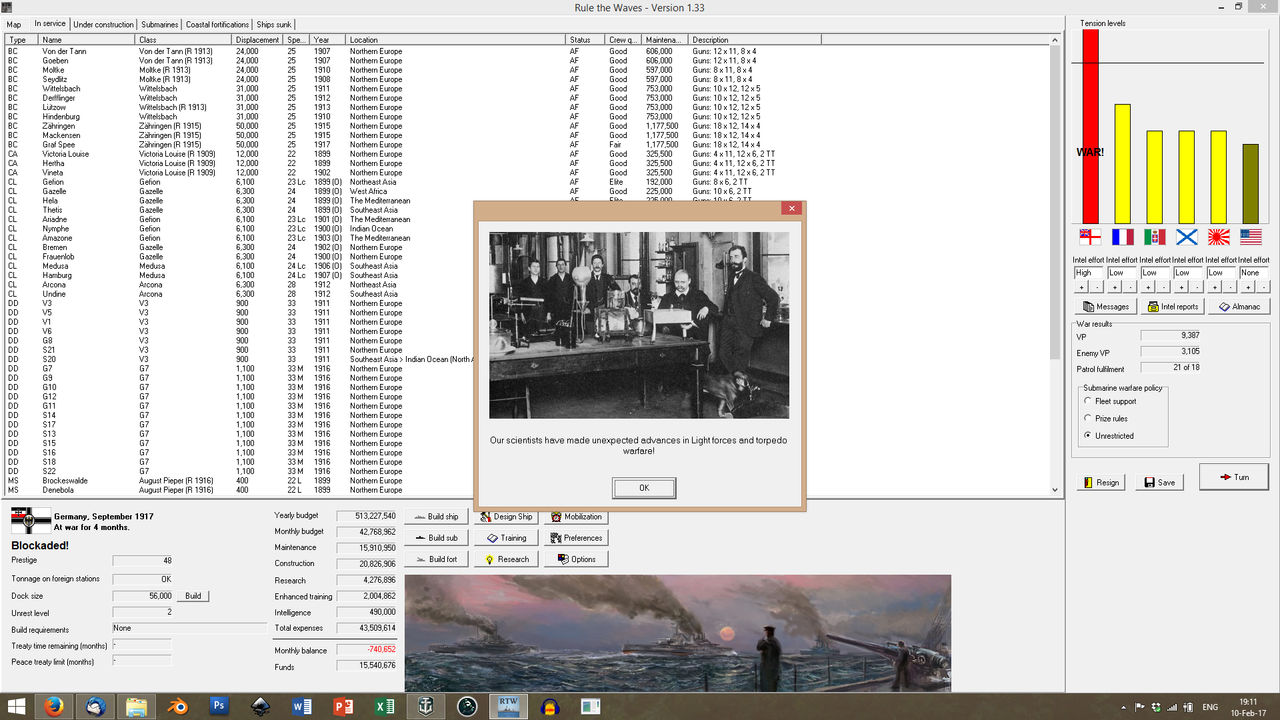
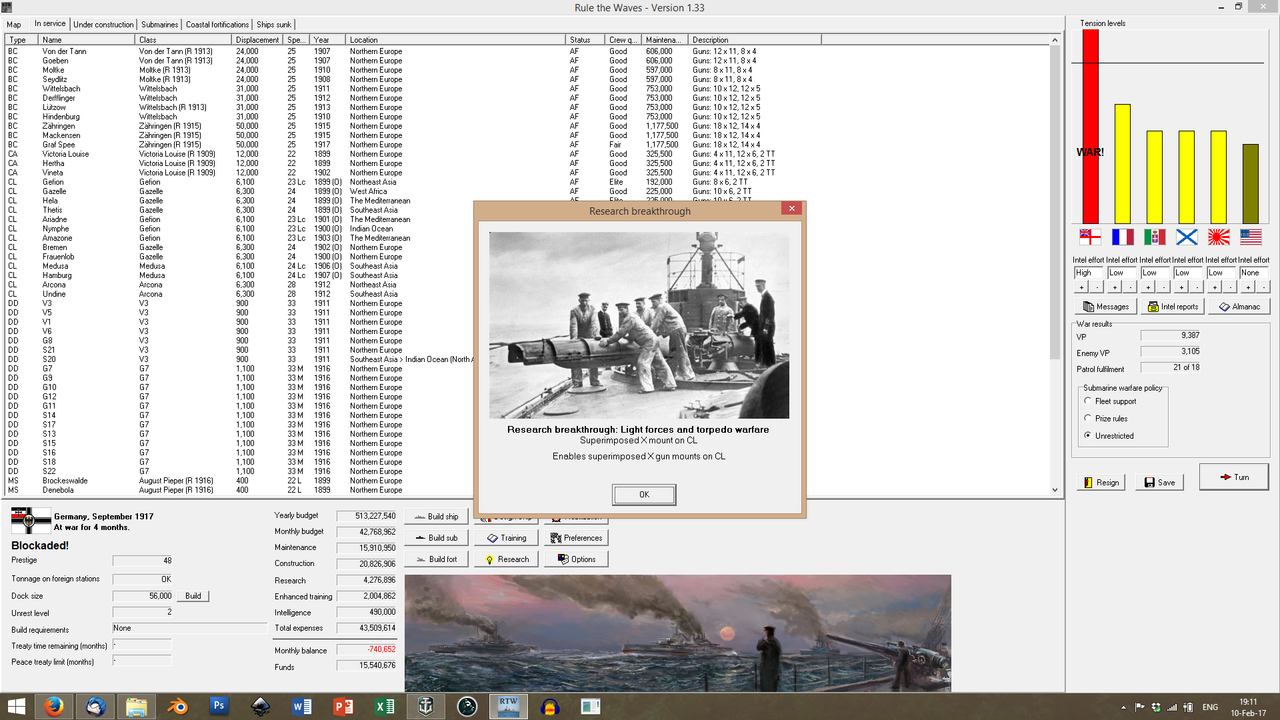
Hmmmm. While one can hardly fault the R & D department for their efforts, light cruisers are simply not the German...
thing anymore. Not when the
Prinz Heinrichs and the
Hansas so greatly outperform the light cruisers of other nations.
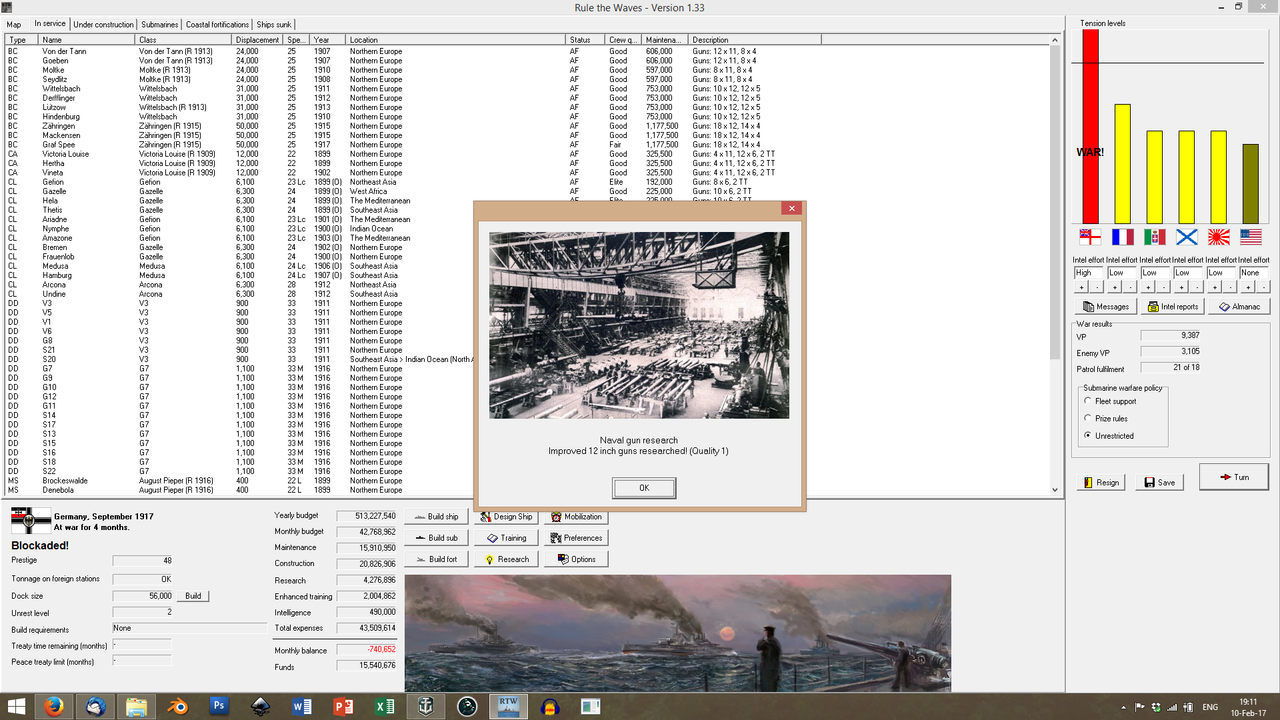 THIS
THIS, on the other hand, has Tirpitz, Hipper and Sheer drooling. The potential benefits from equipping the
Zähringens (never mind the
Wittelsbachs) with the new 30.5 cm SK L/60 rifles would be
enormous. But there is
no question of taking the biggest and nastiest capitals in Germany's fleet out of active service for now.
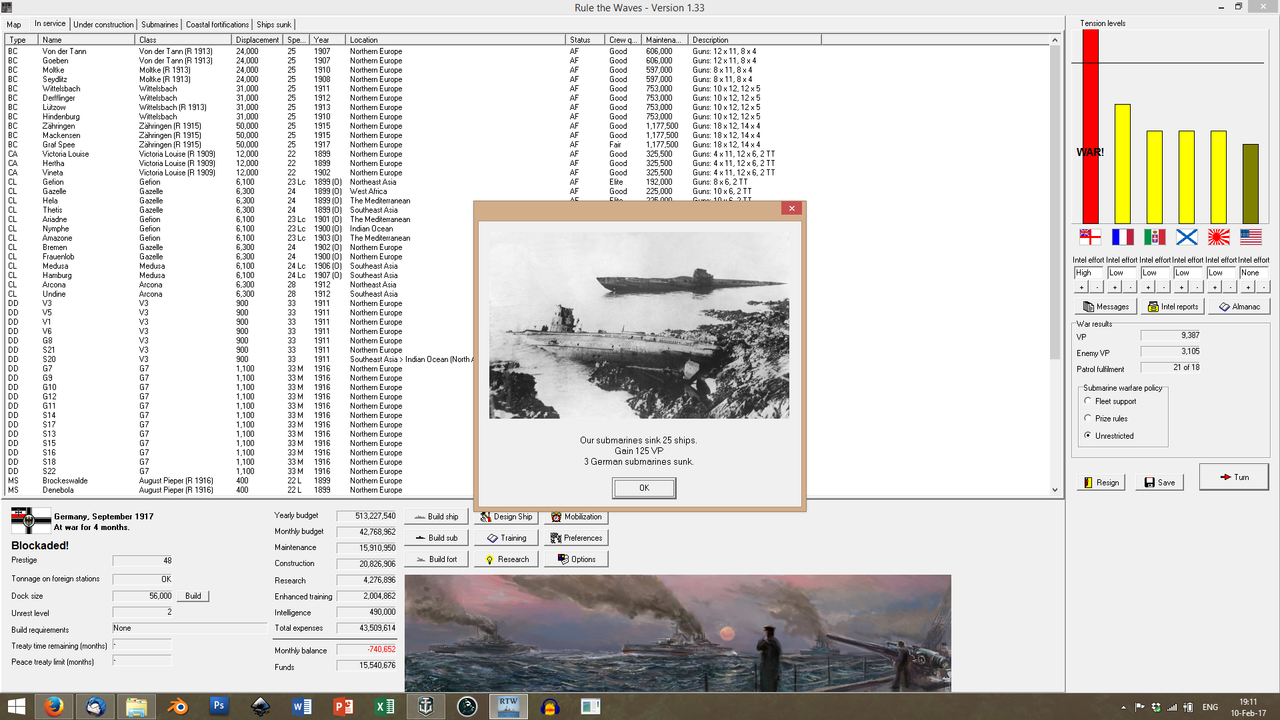
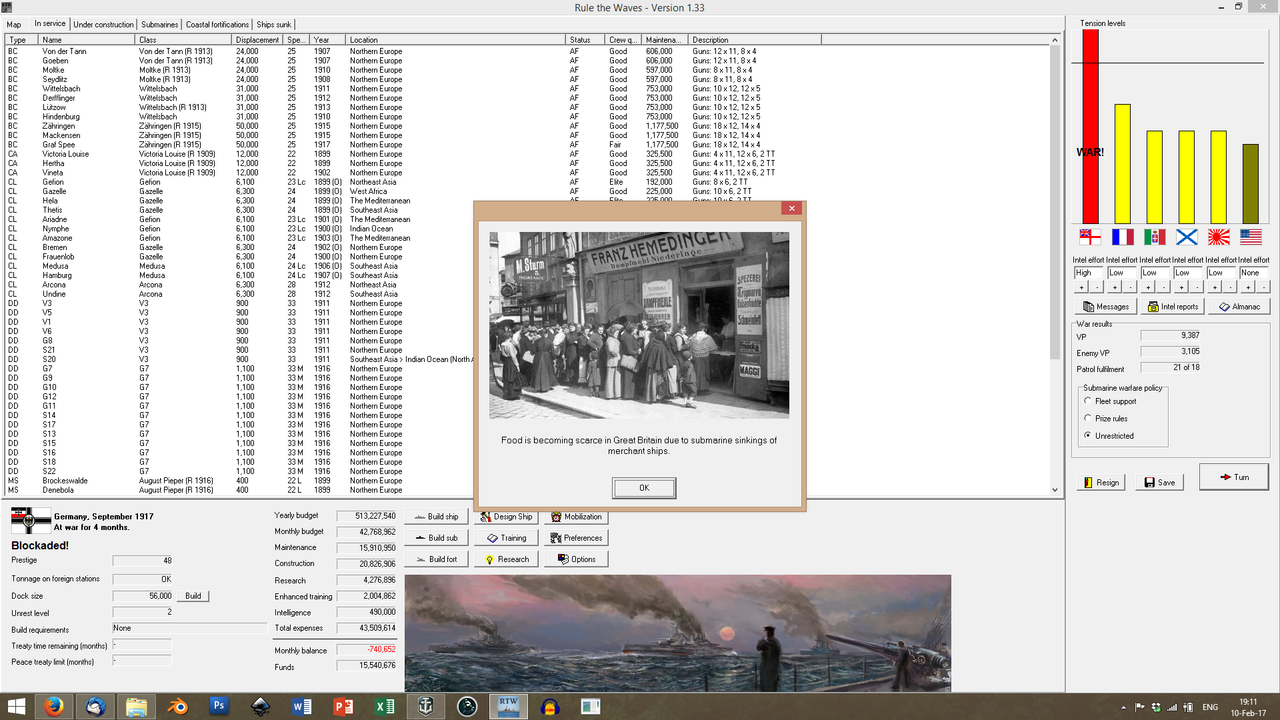
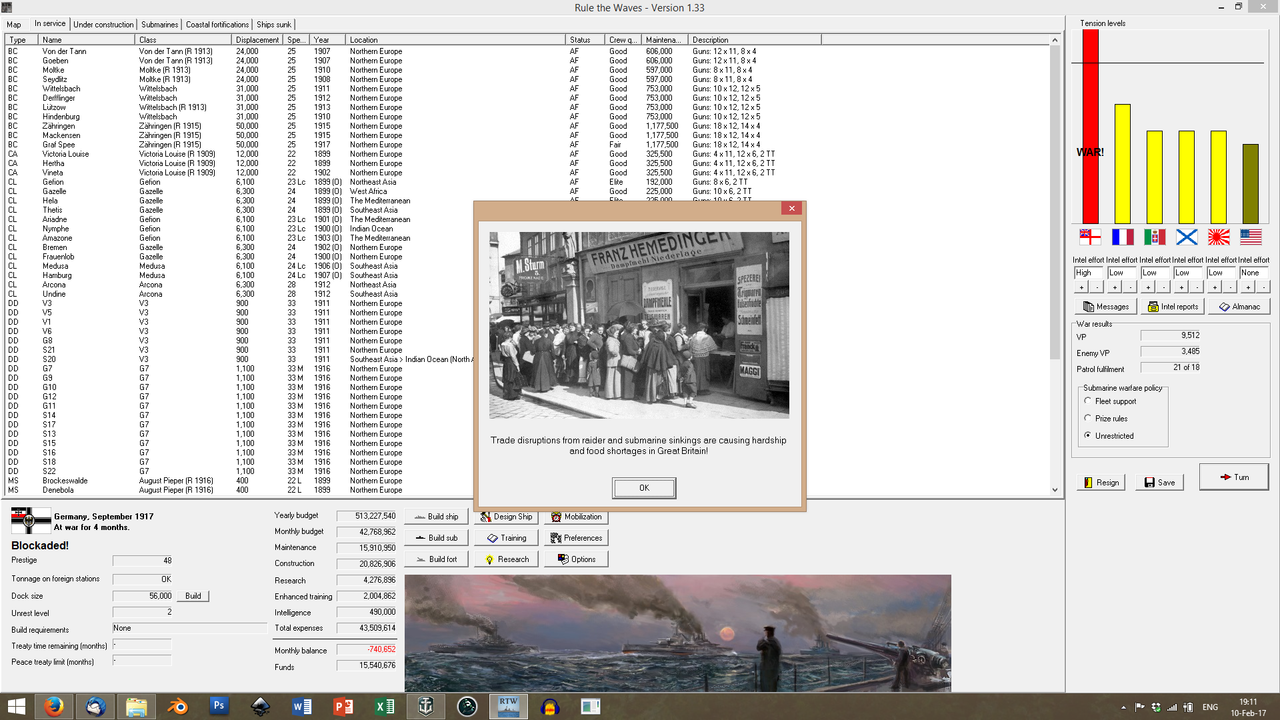
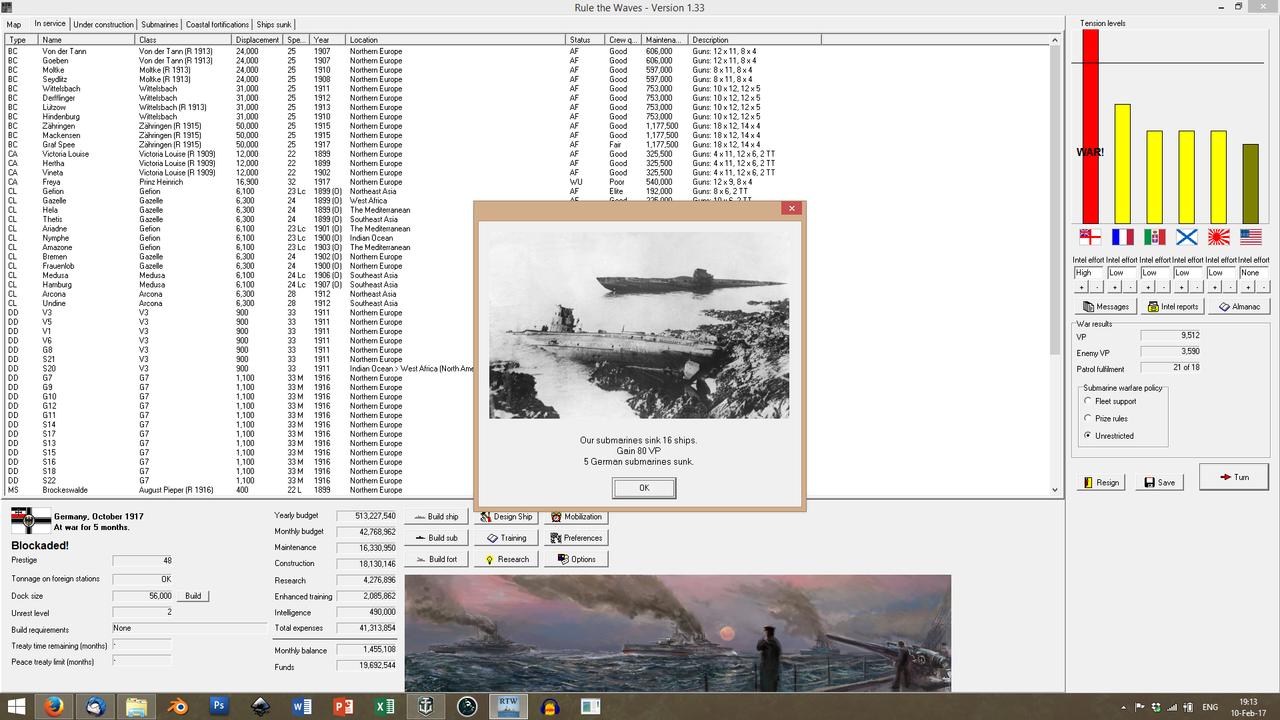
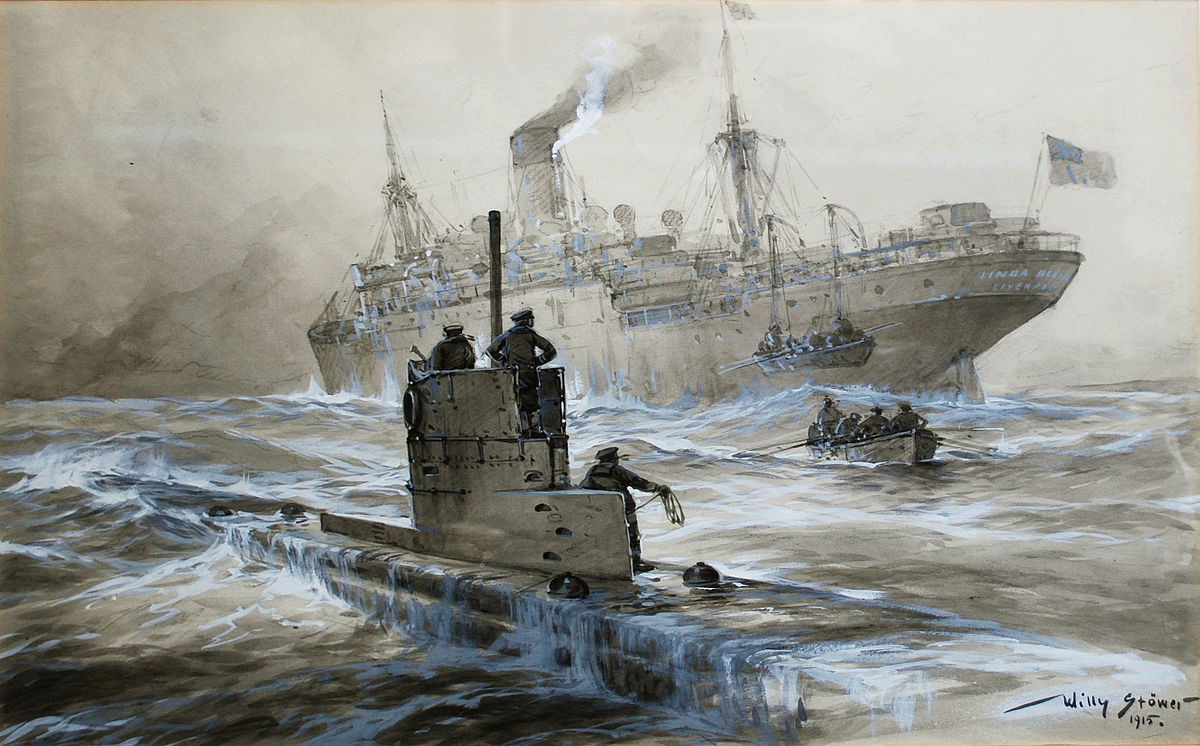
German submarine warfare continues to bleed the Brits dry, although their performance in October leaves something to be desired. Increased U-Boot losses may be due to the launch of new British patrol ships; or the implementation of new ASW techniques. The
Admiralität keeps a close eye on the situation.
What is clear, however, is that it
works, for now at least. [Holy ****,
two 'starvation' triggers in September!]
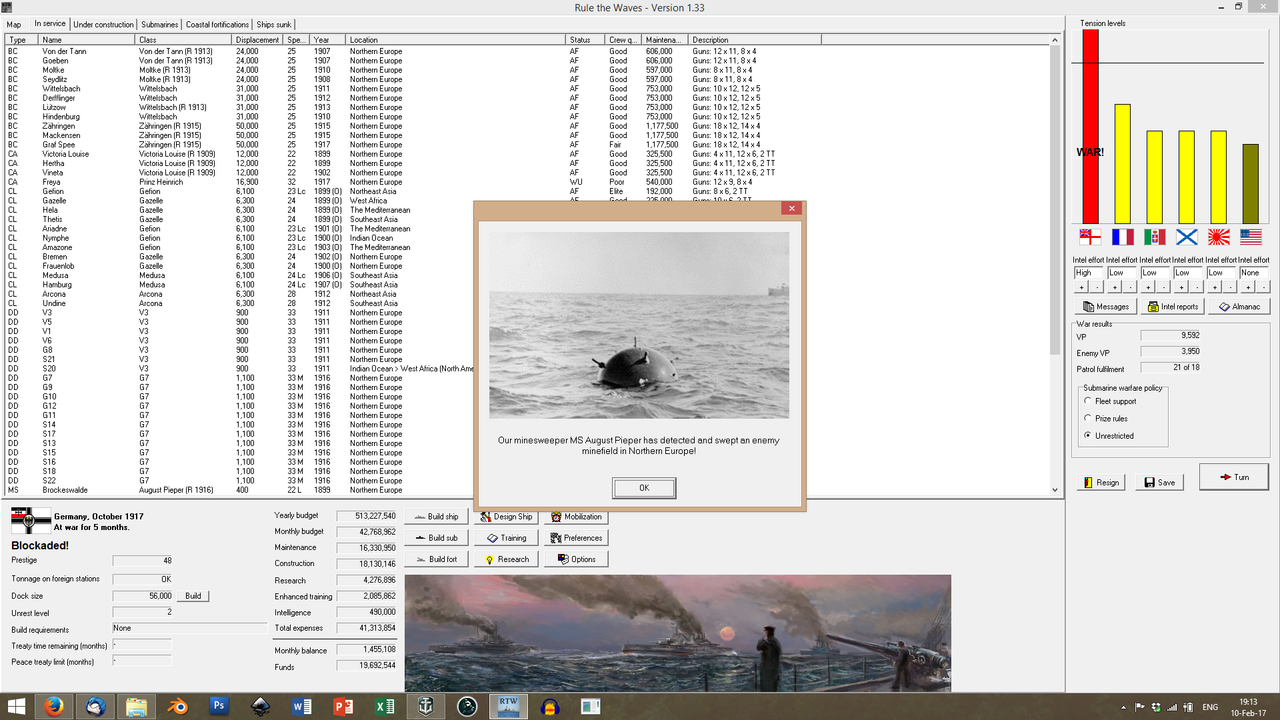
And the bloody
Piepers (the
name ship, no less, well done you little scamp!) find and clear another British minefield in the North Sea.
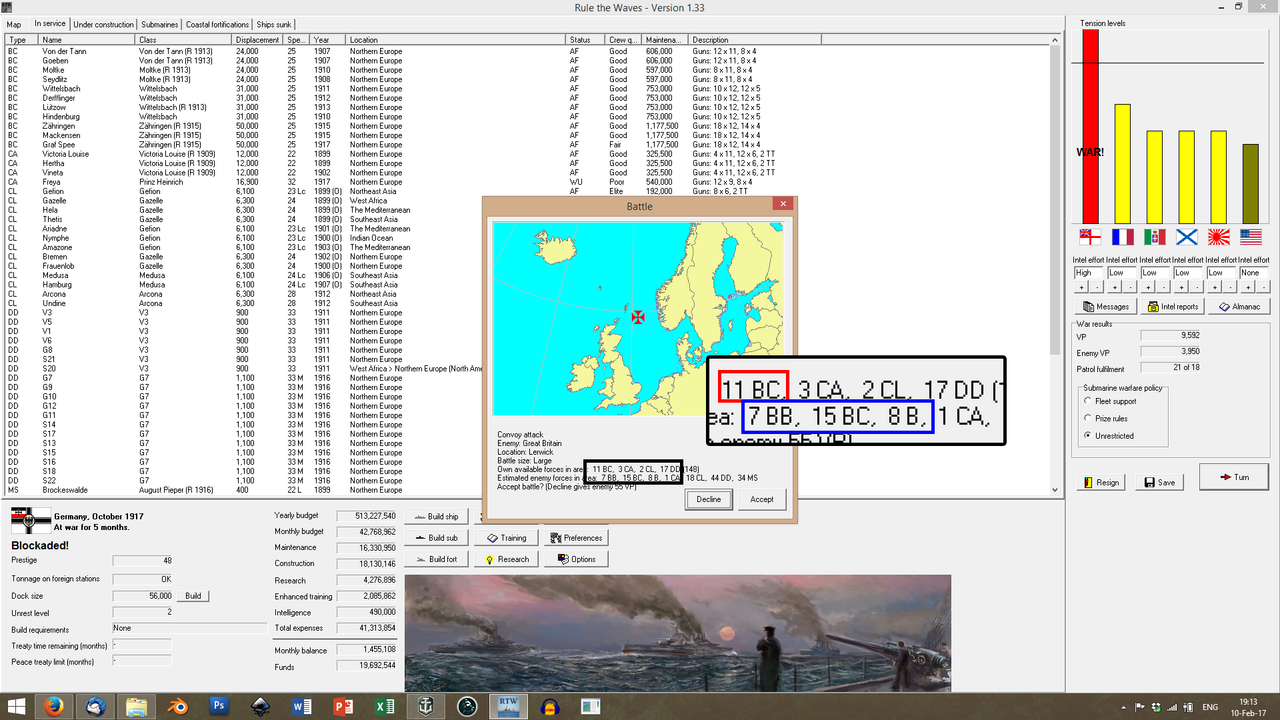
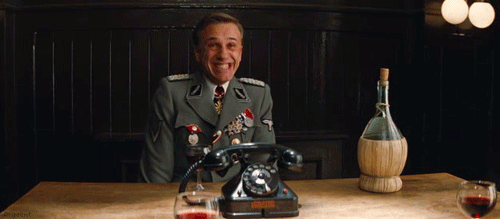
Oho. Ohohohohoho.
On the evening of October 2nd, U-110 reports from the North Atlantic near the Faroes. There is a
massive convoy moving in, under heavy capital ship support. They have tentatively identified at least
one Sutlej-class battlecruiser: the newest and most dangerous 15-inch British capitals.
Mackensen is currently at the yard, with condenser troubles; but the rest of the
Hochseeflotte sorties
immediately and in force, making their best speed to intercept. This is what Galster and Tirpitz have been waiting for: a chance to choose the engagement and to encounter a small, vulnerable part of the Grand Fleet with the maximum available force on their end.
The Germans bring five
Schlachtkreuzer to the fight. The
Wittelsbach, Derfflinger and
Hindenburg lead the fleet as a scouting element in force, with a small
Zerstörer screen. The
Zähringen and
Graf Spee follow them as a main strike element, escorted by
Hertha, Victoria Louise and
Vineta. Their flanks are guarded by
Frauenlob and
Bremen and their own complement of
Zerstörer.
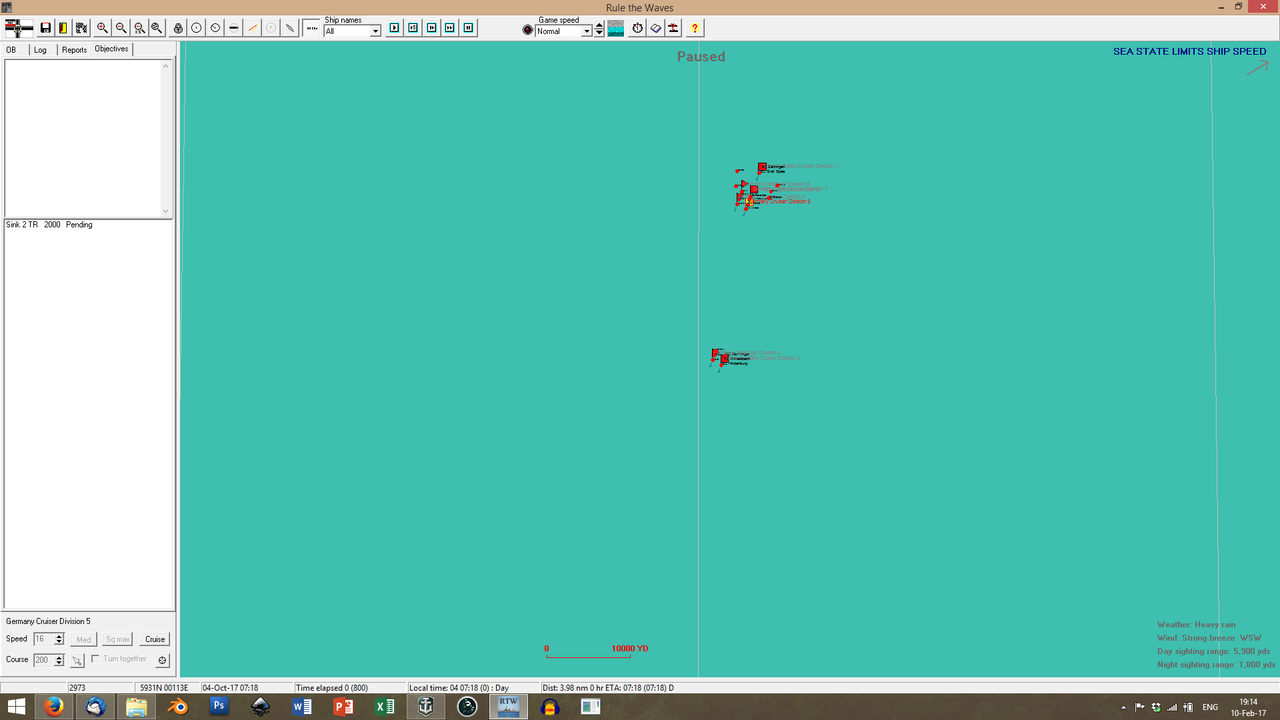
Unfortunately, weather worsens, quickly. By the time the German forces reach the expected intercept point near Lerwick, in the early morning of the 4th of October, they are sailing into a gale, that swamps the decks of the
Zerstörer and limits visibility to a maximum of just under 6k yards.
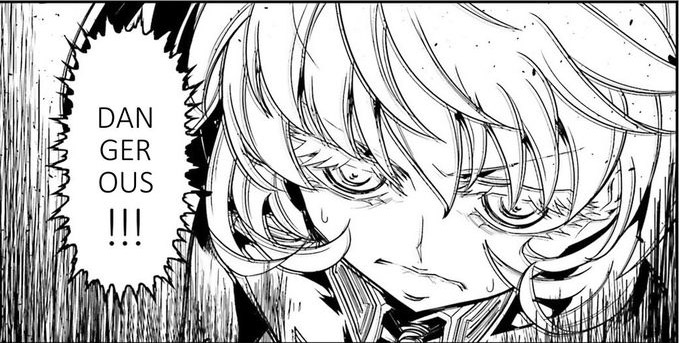
Hipper, from on board the
Wittelsbach suggests that the force withdraw: an engagement under these circumstances would be a gamble that the Germans can ill afford. Sheer, captaining the
Graf Spee, concurs. The German force turns to the south.
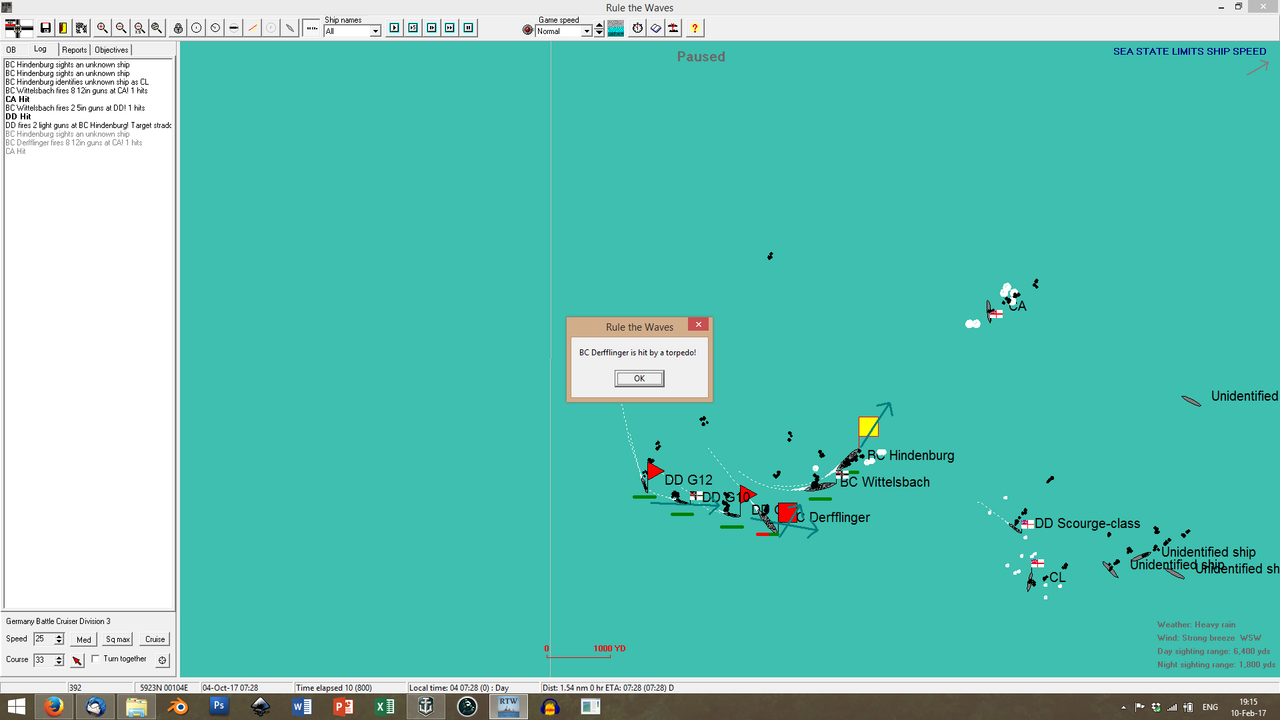
Ten minutes after that fateful decision, a cluster of dark shapes emerges from the rain and squalls, less than two thousand yards to the east of Hipper's force. The
Schlachtkreuzer go into immediate evasive maneuvers, turning their bows toward the sleek black shapes of the British destroyers; but it's too late for
Derfflinger. A torpedo, either lucky or perfectly aimed, hits her in her aft, locking her rudder for a few critical minutes and leaving her unable to follow her sisters in their turn towards the north.
In return, the
Wittelsbach opens fire with her main and secondary armaments, scoring a hit against what seems to be a British cruiser to the north-east and raking one of the destroyers with 5-inch fire.
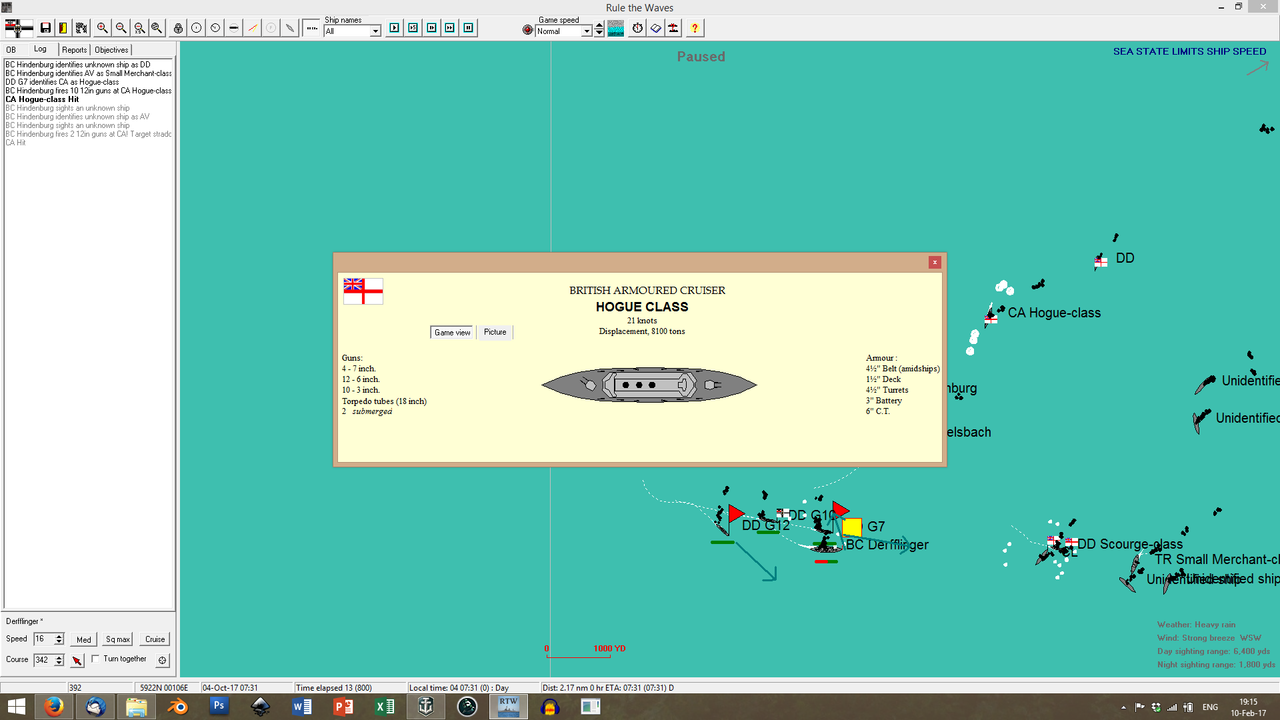
A couple of minutes later, the lookouts identify the British capital. Yes, she's a cruiser: an armored cruiser of the
Hogue class. An old ship - not surprising to see her on convoy duty. By this time,
Hindenburg has her range.
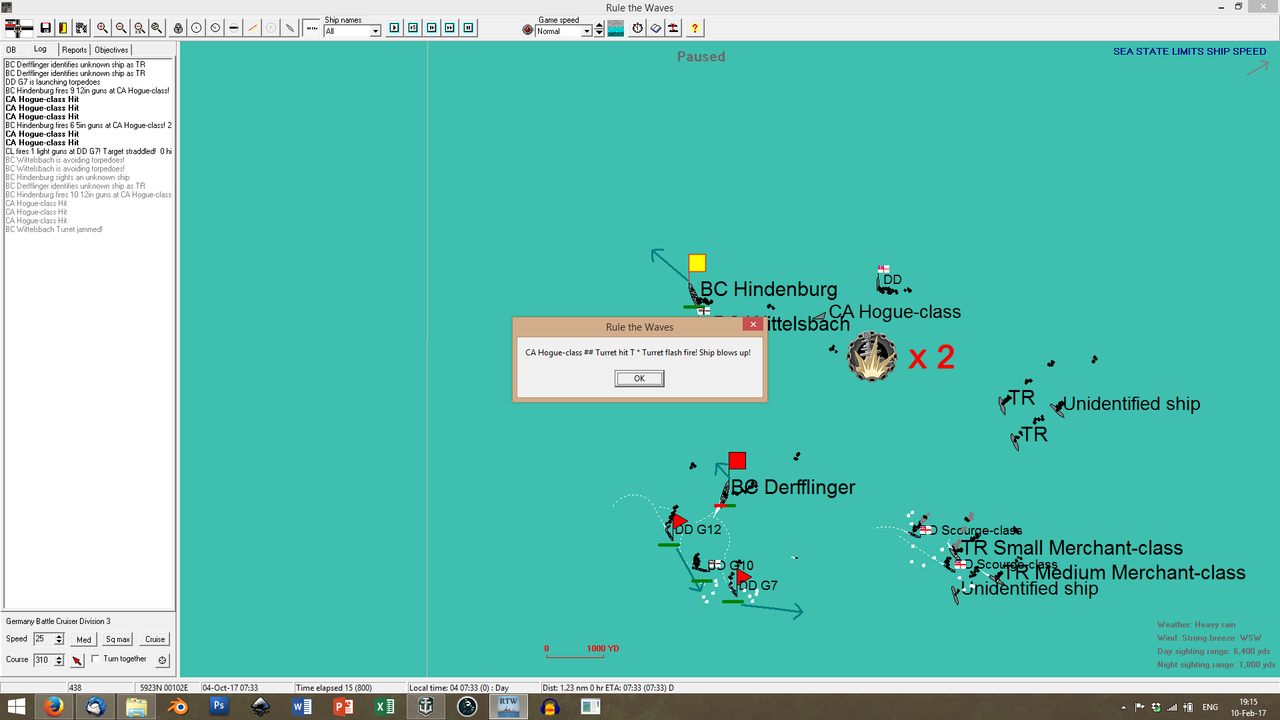

And she blankets the old cruiser with a full broadside of main and secondary guns. At least two shells strike the
Hogue and, for a moment, the German gunners think they were duds; and then the
Hogue goes up like a roman candle, the shockwave of the explosion reaching the low clouds above. If there are any survivors, it's impossible to pick them up in these seas.
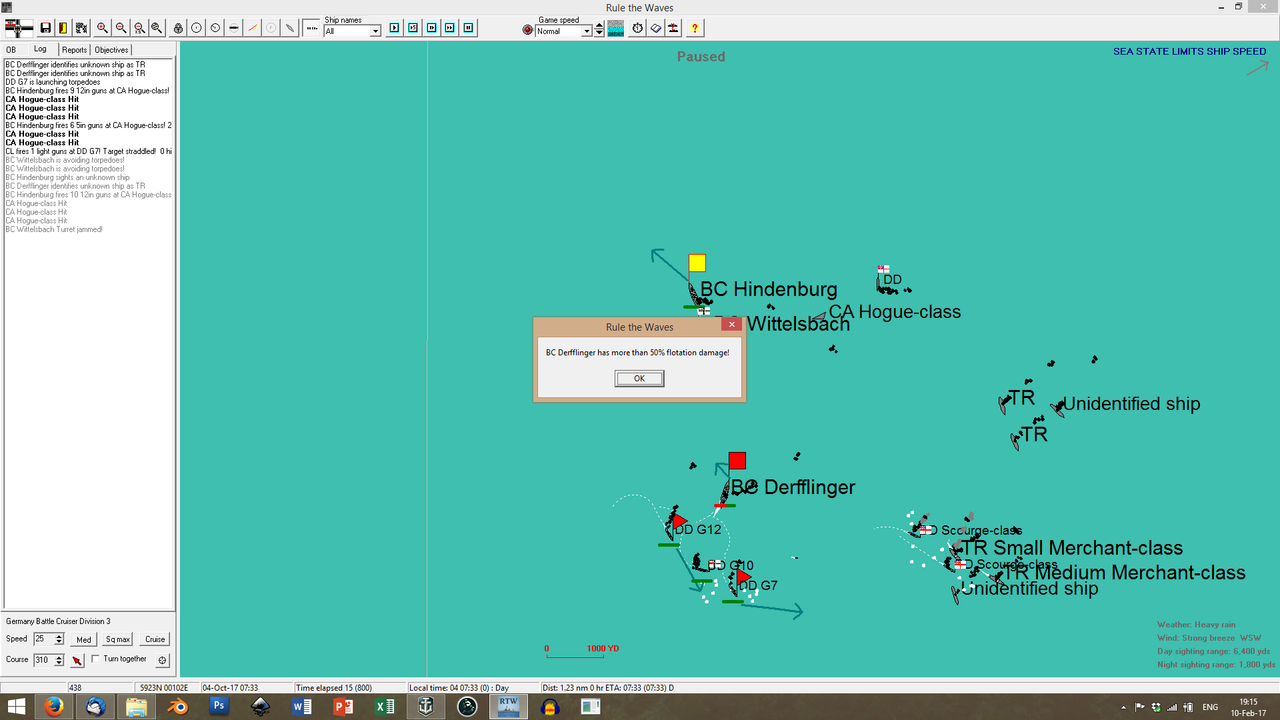
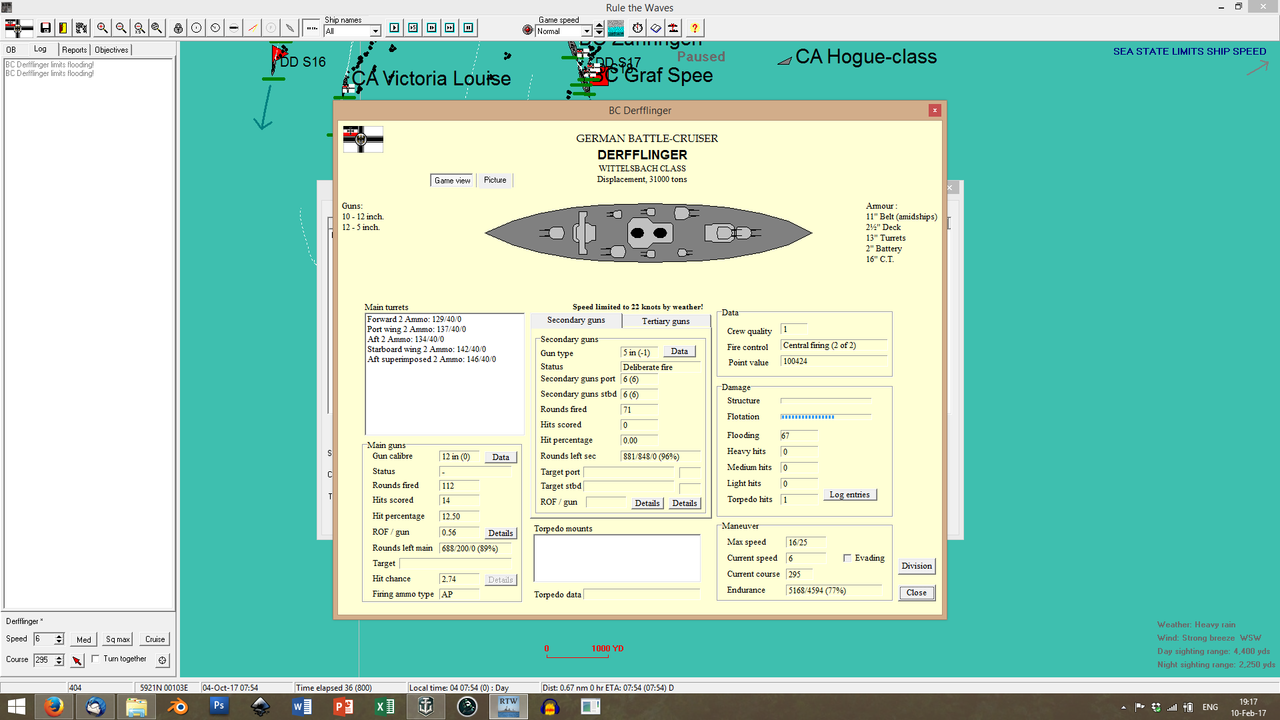
But the same waves that prevent the German
Zerstörer from closing in to assist the castaways, also make life difficult for the
Derfflinger's damcon teams. They have restored steering, but her flooding is less easy to bring under control. Her portside compartments are flooded and it is impossible to access them from outside; two bulheads have ruptured; and she can only do 16 knots. But, thankfully, her pumps are operational; and the water has not reached her magazines. She is crippled, but she can
fight, if necessary; for now, Hipper signals her to retreat towards the north-west, until they bring their flooding under control.
And then, fifteen minutes after the
Hogue's violent death, with the
Graf Spee and the
Zähringen having reached the scene, the
Hindenburg pokes through another squall, to find an enemy capital ship almost two thousand yards to her north-east,
again.
The two ships open fire at each other simultaneously, before their lookouts have the time to identify each other. At this range, it's not
really necessary. The British ship scores one hit on the
Hindenburg's superstructure, a massive shell screaming through the unarmored forward mast structure without its fuze arming. In return, the 12'' German shell punches clean into the foredeck of the British battlecruiser. The hit is followed by one, two,
three internal secondary explosions...
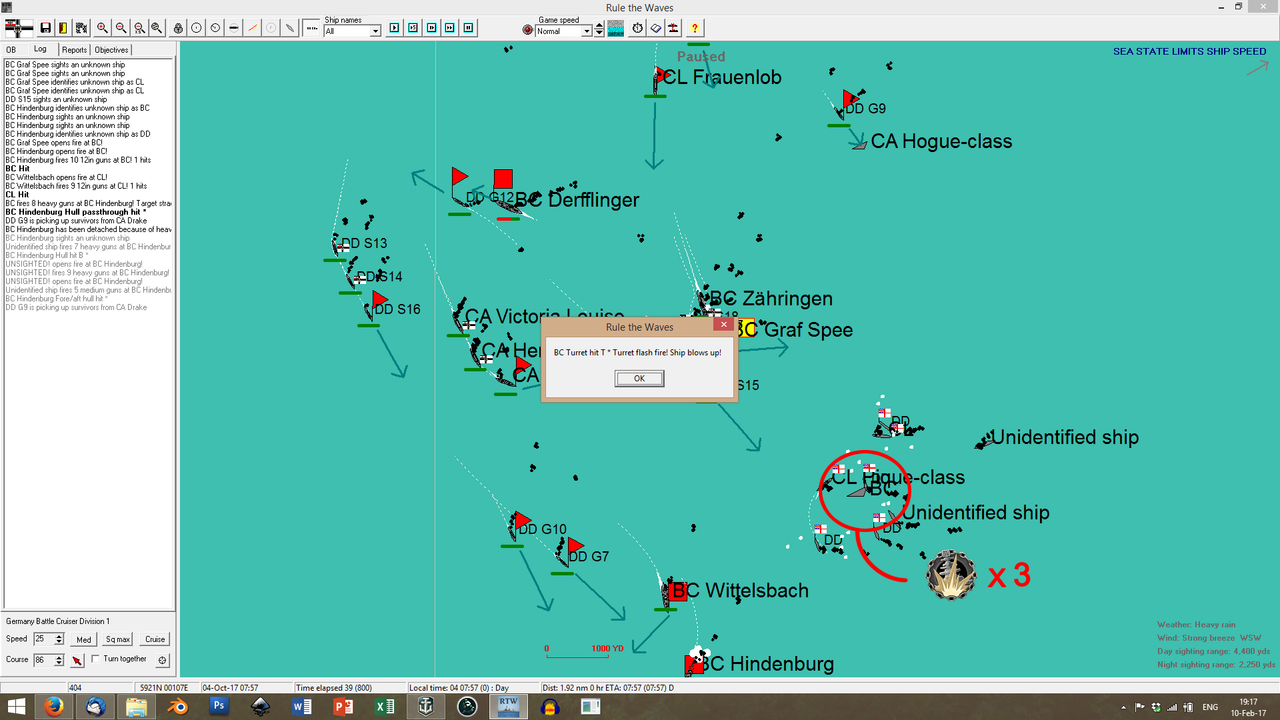
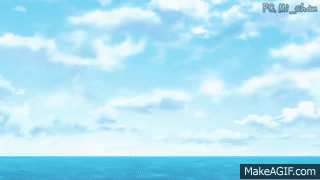
...and then the ship goes up, a massive fireball annihilating everything forward of her smokestacks.
Holy crap.
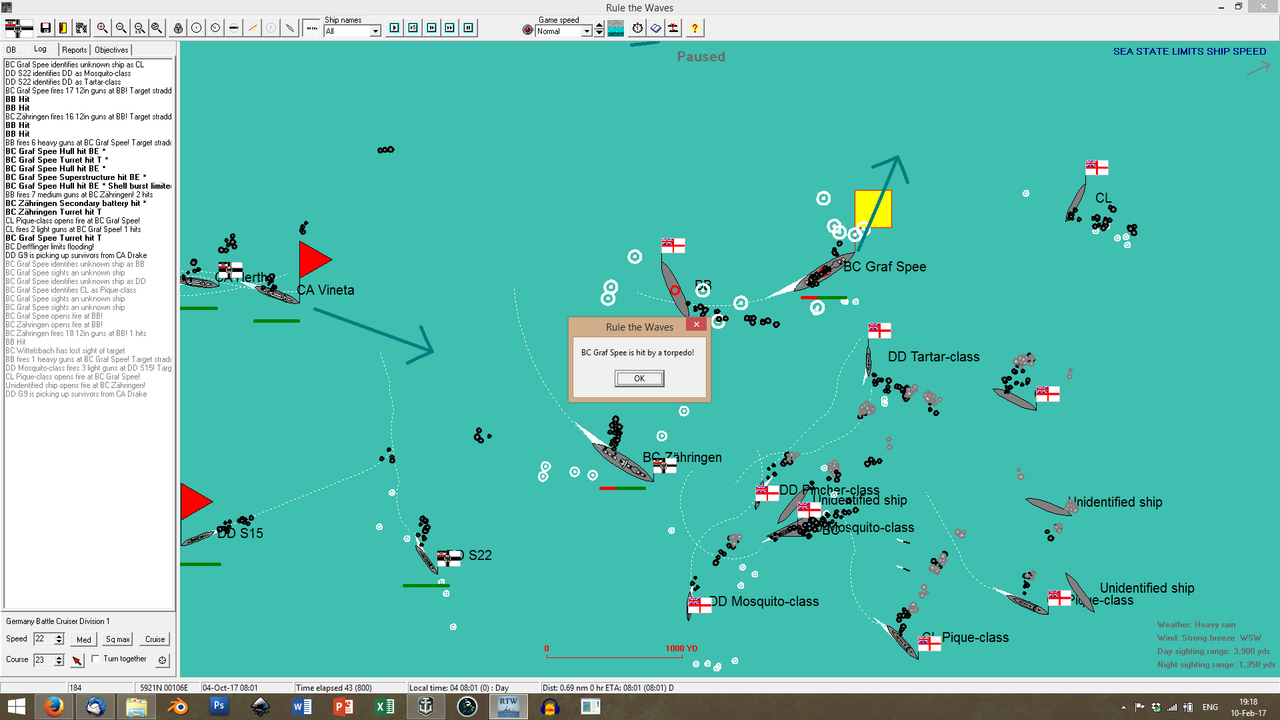
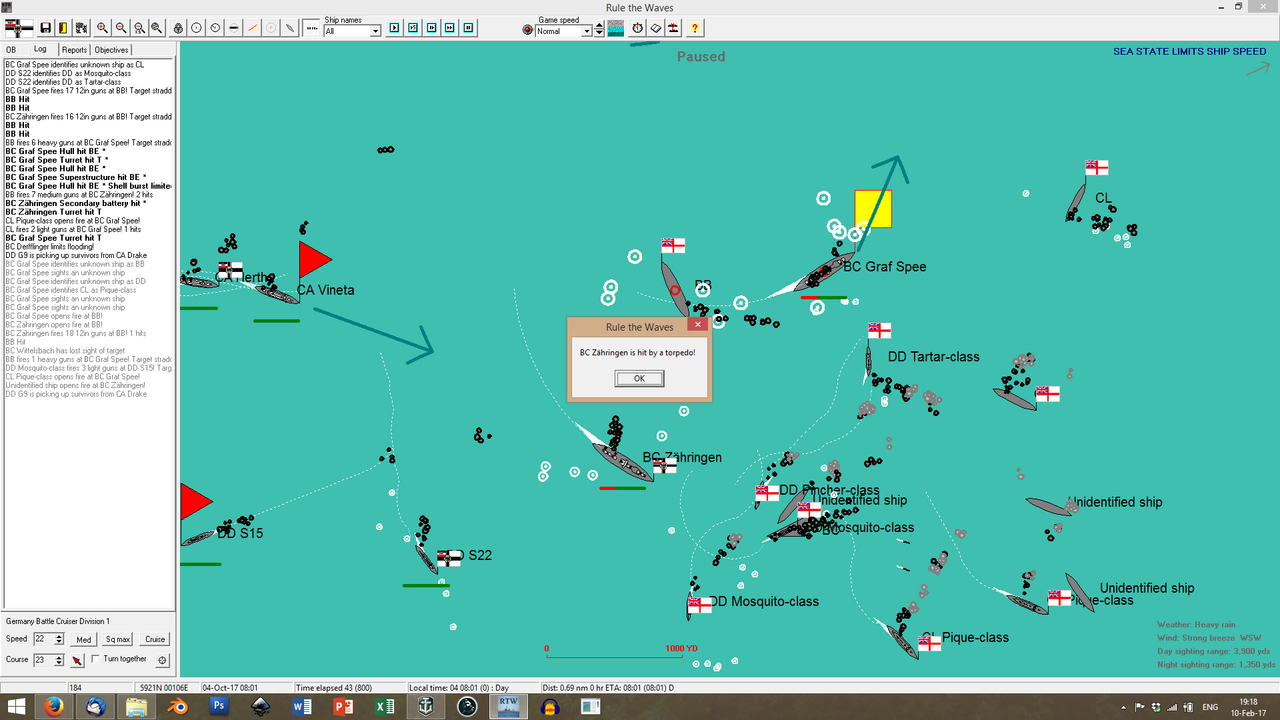
Into this mess, the
Graf Spee and the
Zähringen ride, going too fast to change course in time. They are immediately punished for it, as the British destroyers flush their torpedo tubes in their direction.
But these ships are made of stern stuff. At flank speed, the
Graf Spee passes less than 500 yards from a second British capital, pumping two shots into her belt. The
Zähringen, following her closely, puts another two shots into the enemy ship. And then, the Brit fires back, in a thunder of heavy guns, raking the
Graf Spee with six heavy shots into her forward belt, superstructure,
and her 'C' turret.
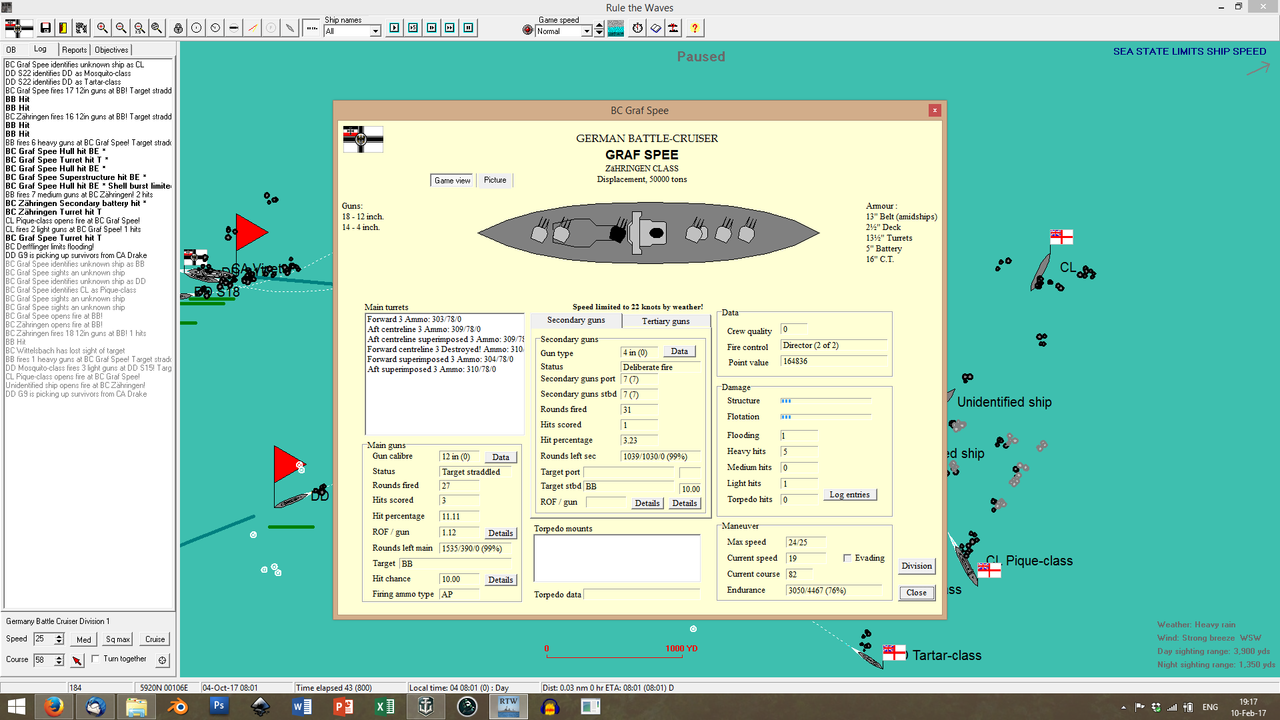
The turret cracks; in an instant, the crew die at their stations.
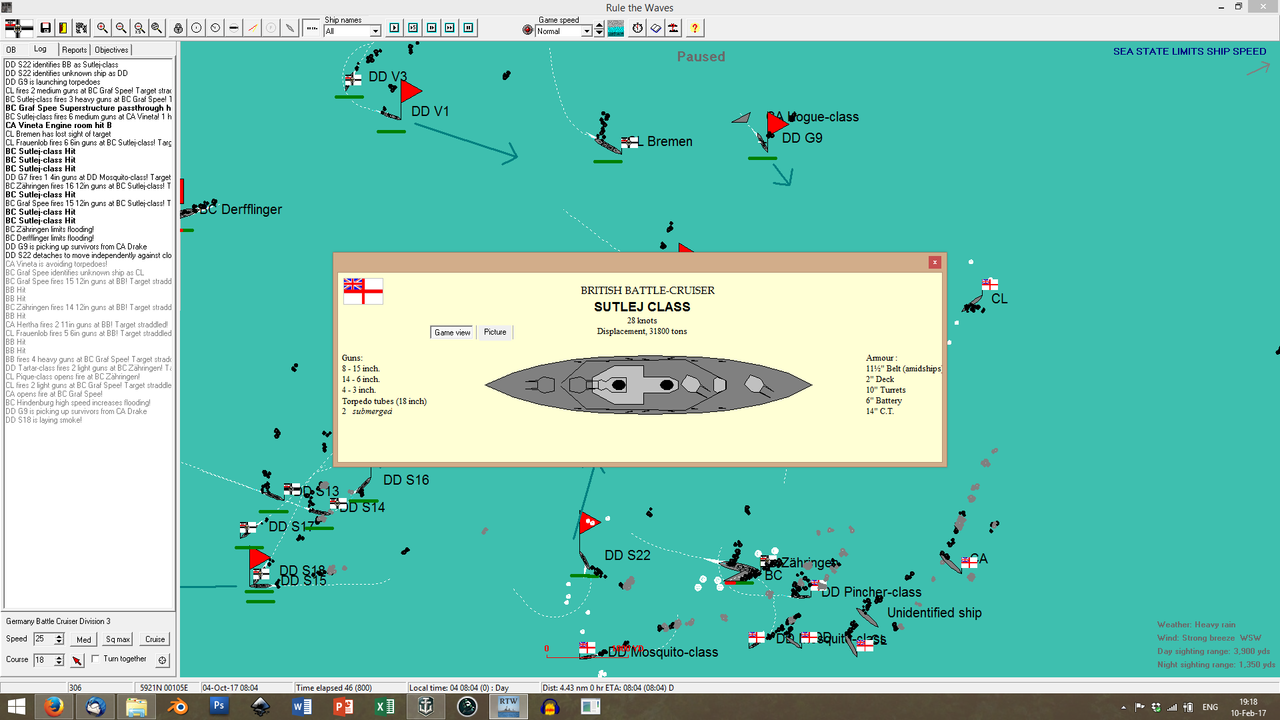
Finally, the lookouts of the
Graf Spee manage to identify their target. She's a
Sutlej alright, and the German guns erupt in fury again. Three more hits are scored by the batteries of
Graf Spee and
Zähringen;
Frauenlob closes into suicidal range and pumps high explosive shots into the Brit's fire directors and superstructure.
The two forward turrets of the
Sutlej fall silent, dead on their bearings; the two rear turrets fire again, but only score an overpenetrating hit on the
Graf's superstructure.
And then
Graf Spee fires back, her 'B' turret putting three shots into the
Sutlej's belt; and
Derffliner, her flooding finally under control, appears from out of a nearby fog bank and thunders a reply to her bigger sister's broadside. The
Sutlej shudders...
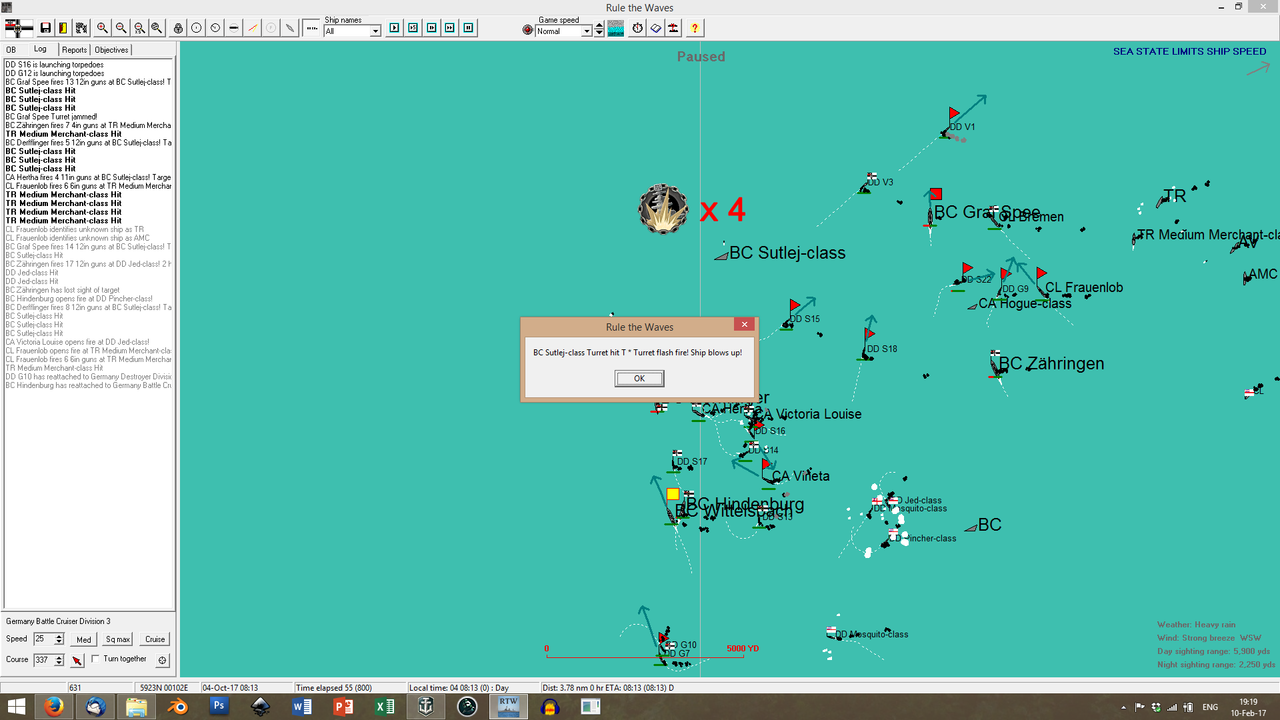
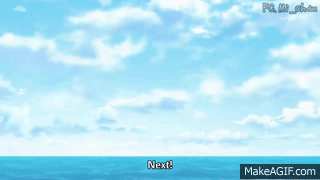
...and goes up, much like her sister.
Meanwhile,
Frauenlob has
reached the transports.
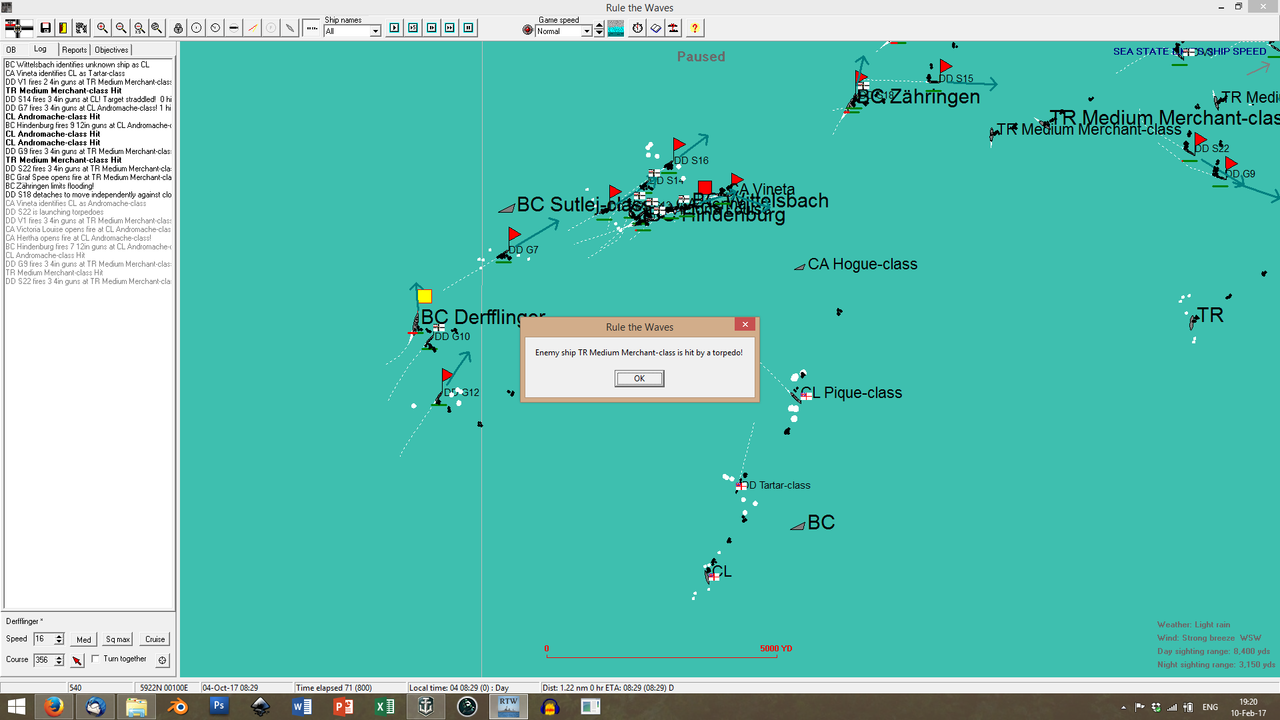
She's immediately followed by the rest of the fleet, and the British destroyers scatter like cockroaches. The
Hindenburg takes the destroyer leader (an
Andromache-class light cruiser) under fire, scoring several hits; the German
Zerstörer take up the hunt.
Frauenlob and
Bremen deal with the convoy, boarding and taking on the crews before sinking the ships with torpedoes and gunfire.
The battle is over.
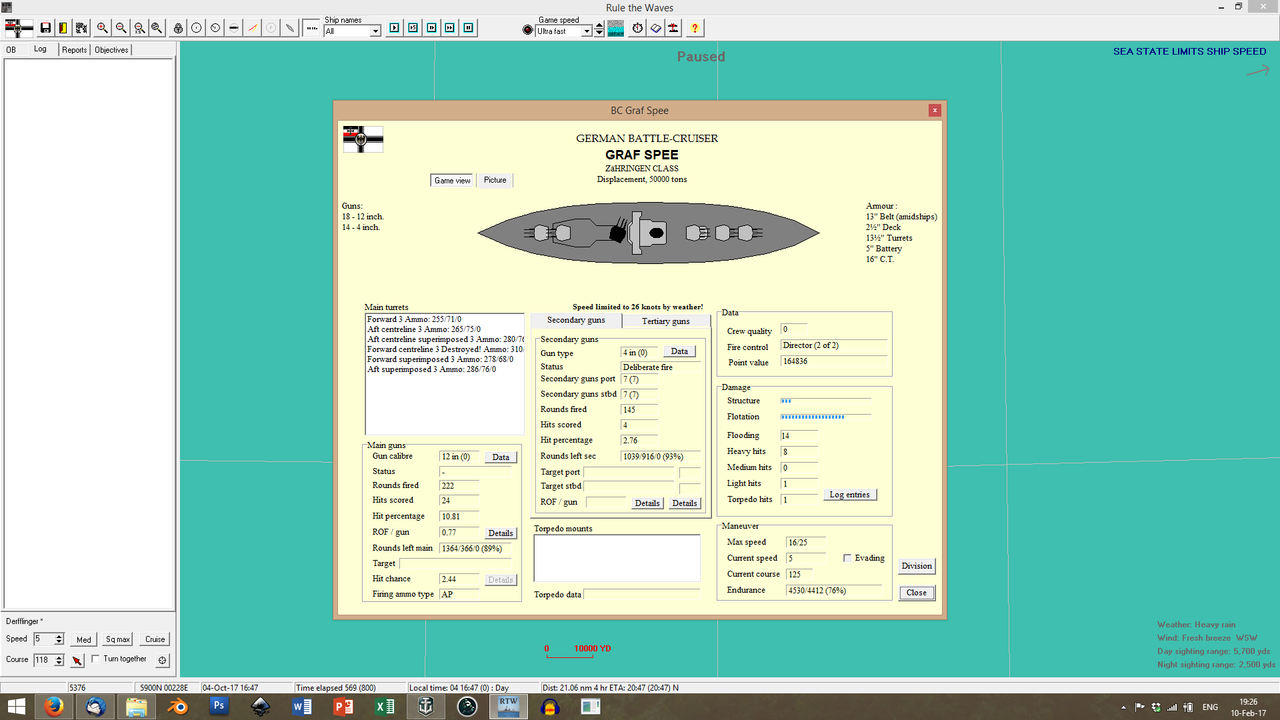
And a good thing too. The German ships have suffered considerably and the
Graf Spee floats
very low at the waterline. Note that she and the
Derfflinger have not suffered much
damage; it is the
flooding from the torpedo hits that threatened their survival.
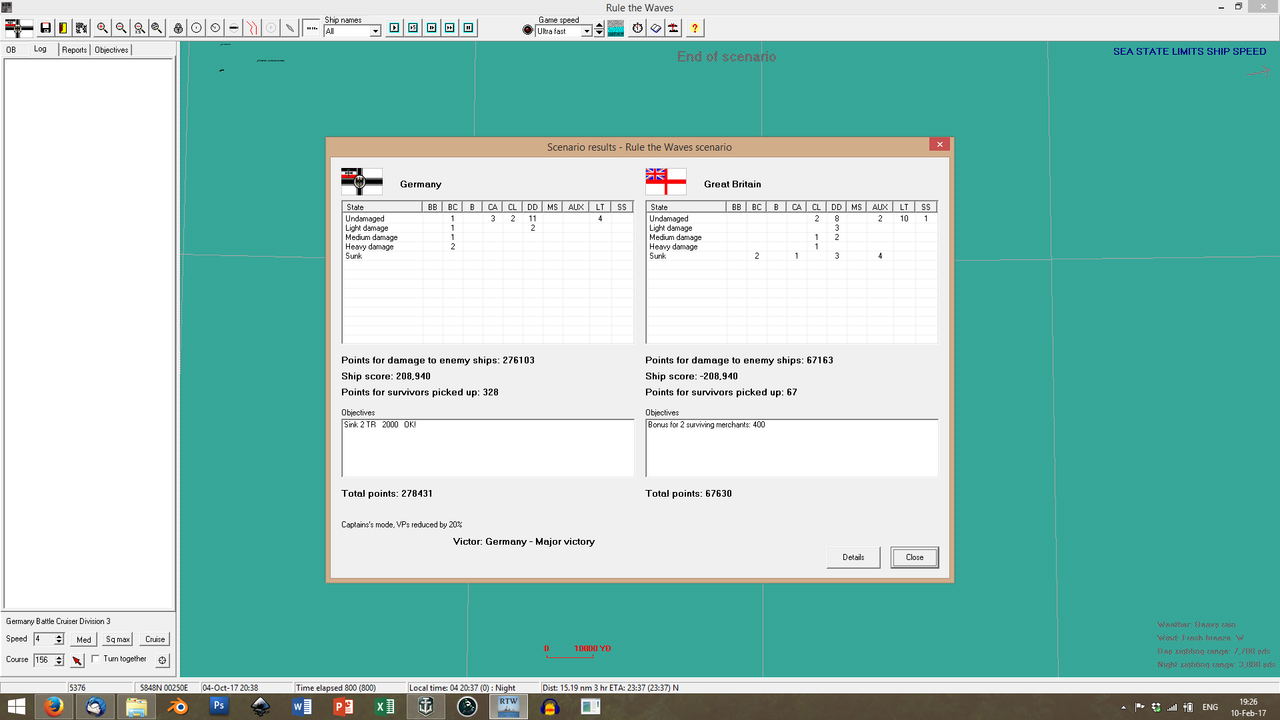
But they make it home, despite the best efforts of the British to intercept them. U-Boote cover their retreat path; they are in Helgoland by noon of the 5th of August.
With the exception of the unfortunate torpedo hits, it's
textbook fight and victory; and the Kaiser is jumping for joy. The
Zähringens have given a good accounting of themselves, tanking most of the damage that would have otherwise been spread around the fleet and yet surviving to fight another day; the convoy was sunk; and the British have lost two of their most modern (and dreaded) 15-inch battlecruisers, without any returns.
When His Majesty congratulates Hipper, Sheer and the
Admiralität in general, however, Sheer, pale and shaken, states:
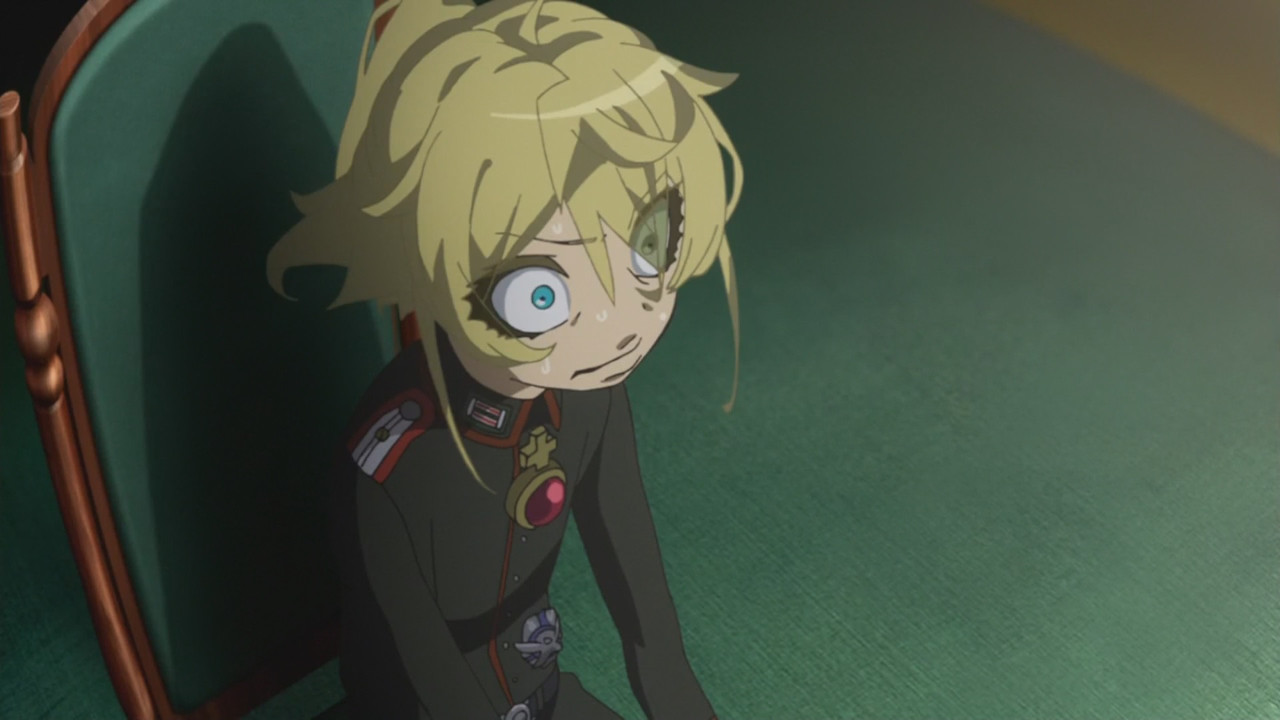
"We must
never fight a battle in such weather conditions again"
And he is right. The
Hochseeflotte was
this close to losing the
Graf and the
Derfflinger; and these ships will now be undergoing extensive repairs. The fleet cannot take such a risk again.
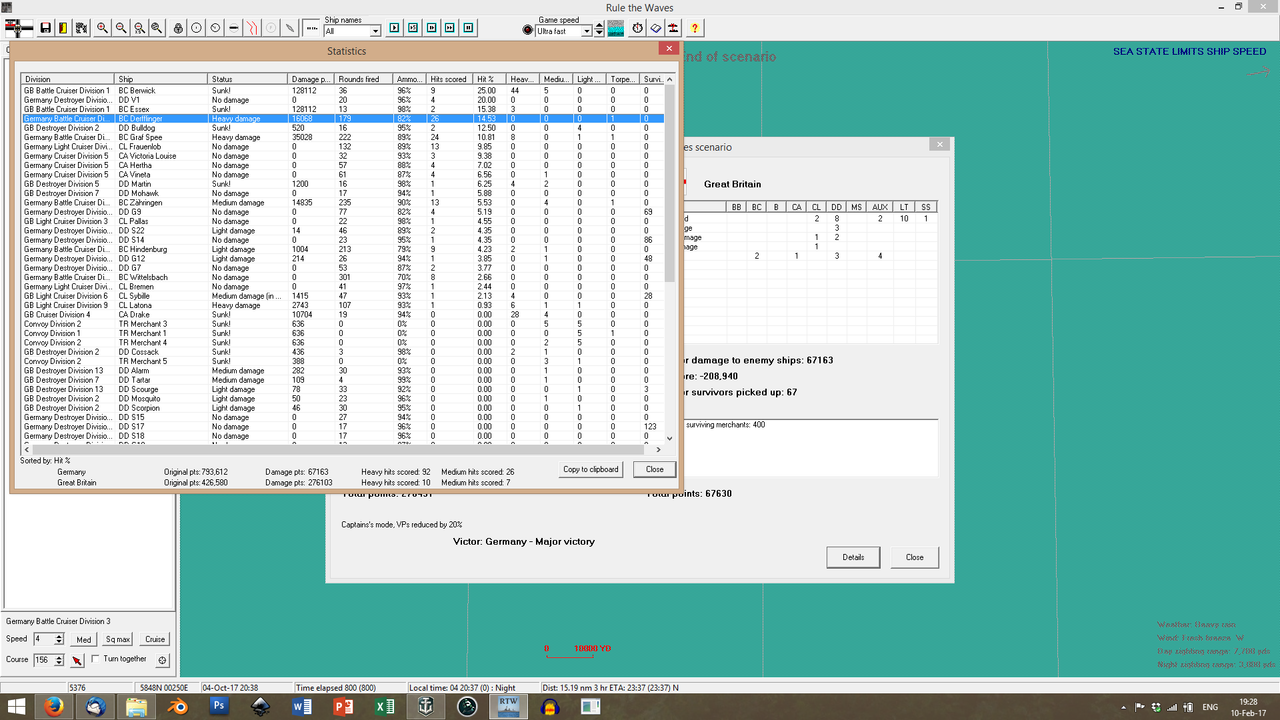
 Nevertheless
Nevertheless, this is still a glorious victory.
The British have lost
HMS Essex and
HMS Berwick, as well as
HMS Drake and three of their destroyers.
HMS Latona, the
Andromache-class light cruiser that
Hindenburg had taken under fire only barely manages to reach Scapa Flow. And, out of the six massive tankers that the British were escorting, only two managed to slip away in the rain.
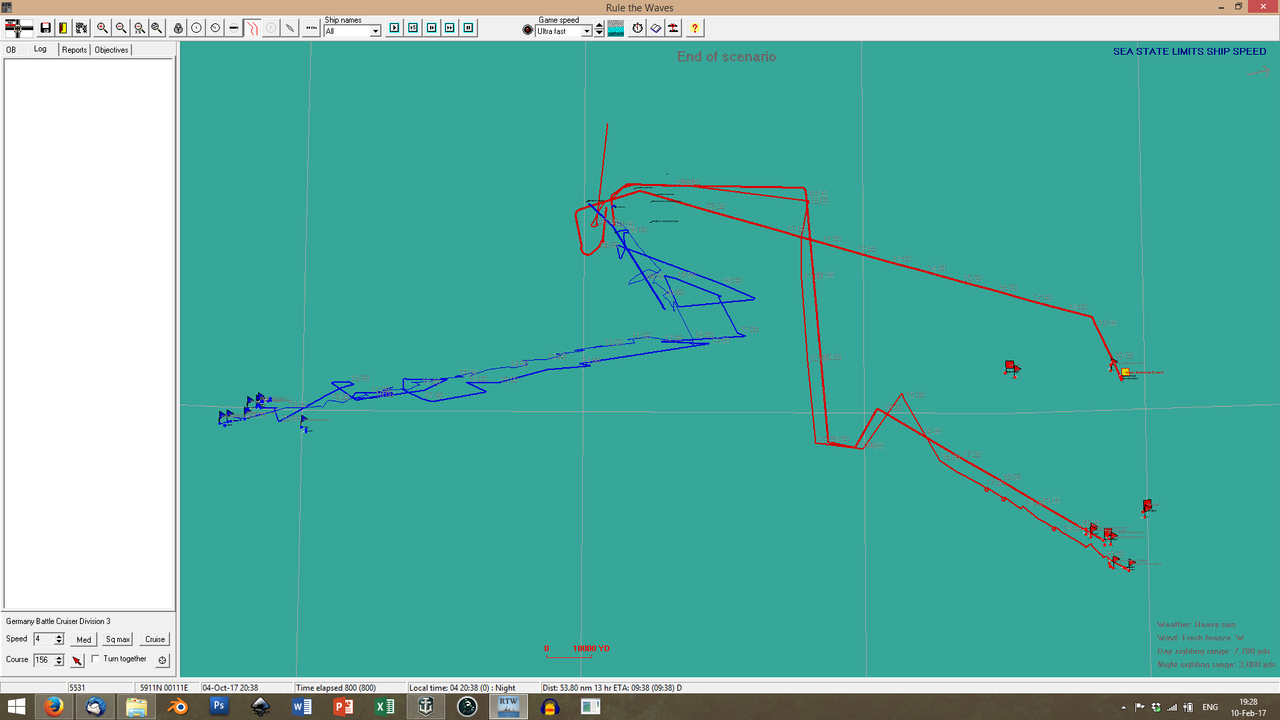
Once again, the
Admiralitätsarchiv comes to our assistance with their map records. Note the 'node' in the centre of the map, where the quick decisive engagement took place; and the paths of retreat of the German forces (south-east, to Helgoland) and the British surviving ships (south-west, to Scapa Flow).
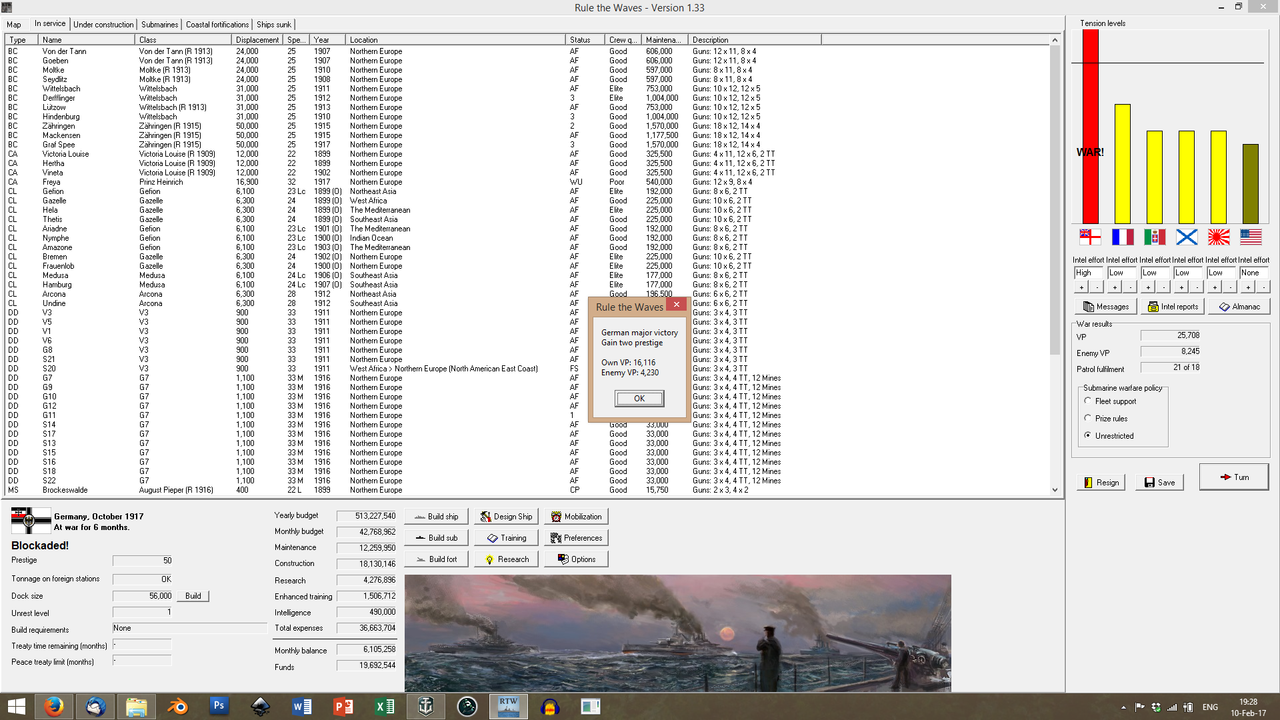
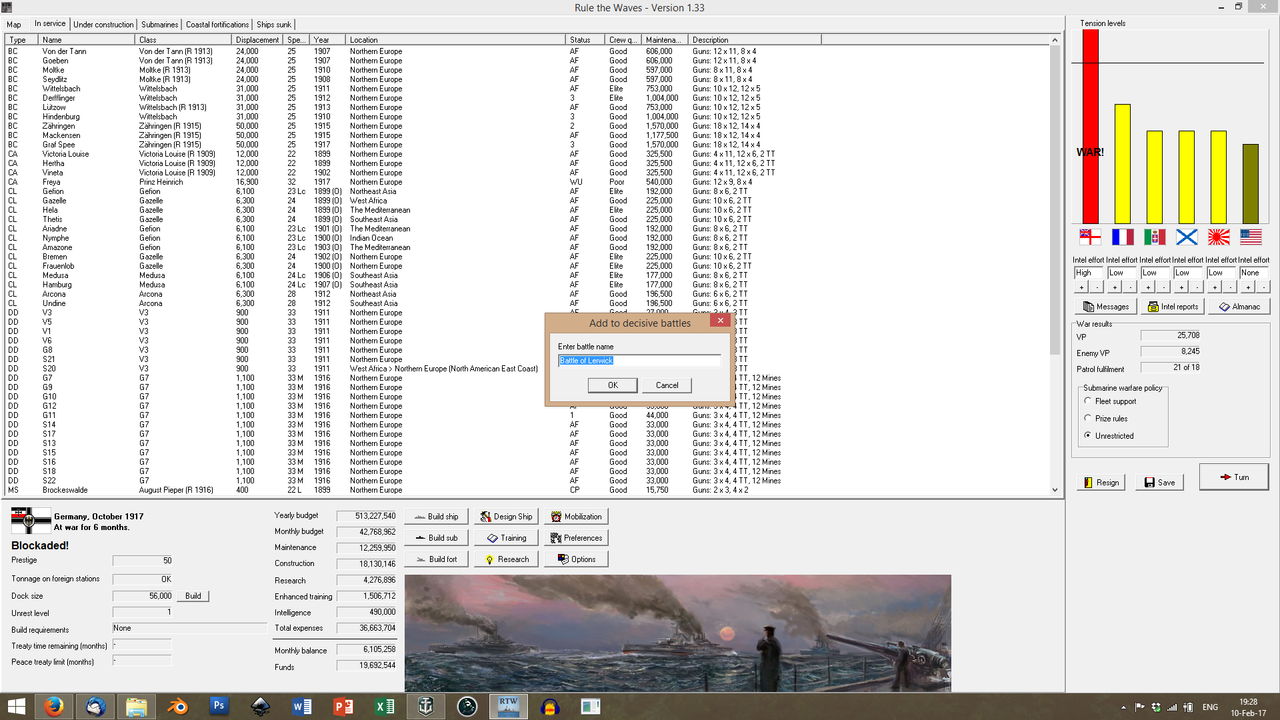
It is a glorious victory, indeed, made even more devastating to the British by the fact that they lost three capital ships to flash fires and magazine explosions.
For a long time, the reasons for these devastating explosions were obfuscated by the Admiralty: originally, the blame fell on the weak belt and turret armor of the British ships. However, as future research into these battles and the records of the Admiralty would prove, this was, in fact, a disingenuous campaign by certain high-ranking officers of the Admiralty, to cover up near-criminal negligence in the implementation of the proper safety procedures in British ships. Both the
Essex and the
Berwick were sailing with many of their bulkhead doors open, for the ease of their crews, not expecting any action. Furthermore, fire doors and hatches in the turret barbettes and magazines were left opened as crews rushed to their stations. This allowed explosions in the turrets to travel down to the magazines, with disastrous effects. On the other hand, despite having her 'C' turret penetrated by a 15'' shell, the
Graf Spee had survived, because her crew had followed all mandated security precautions
And now, after their experience, the Germans put even more stock on keeping their ships
alive. On the other hand, the British-
-well, how much they learned from the disaster at Lerwick is debatable.